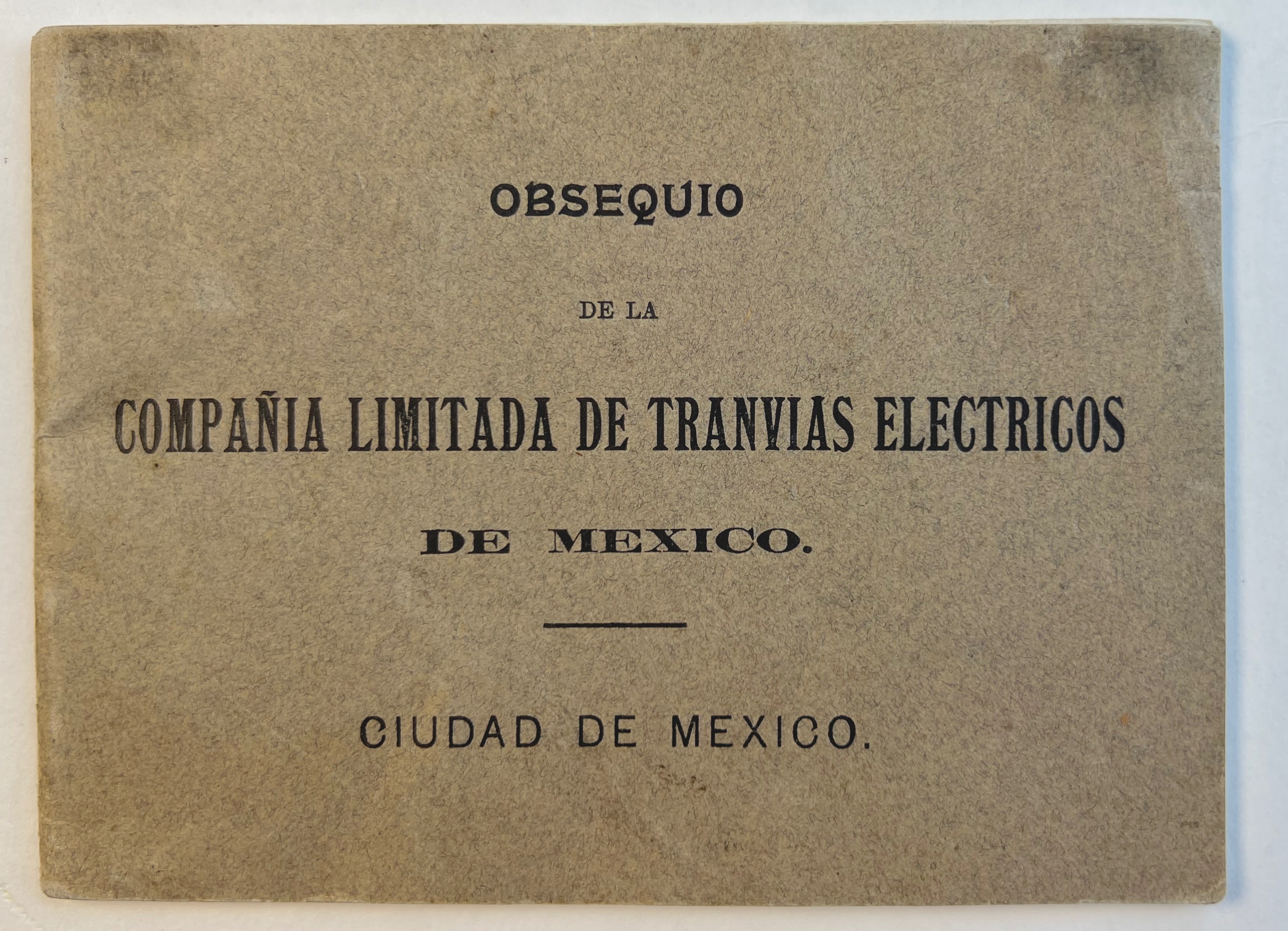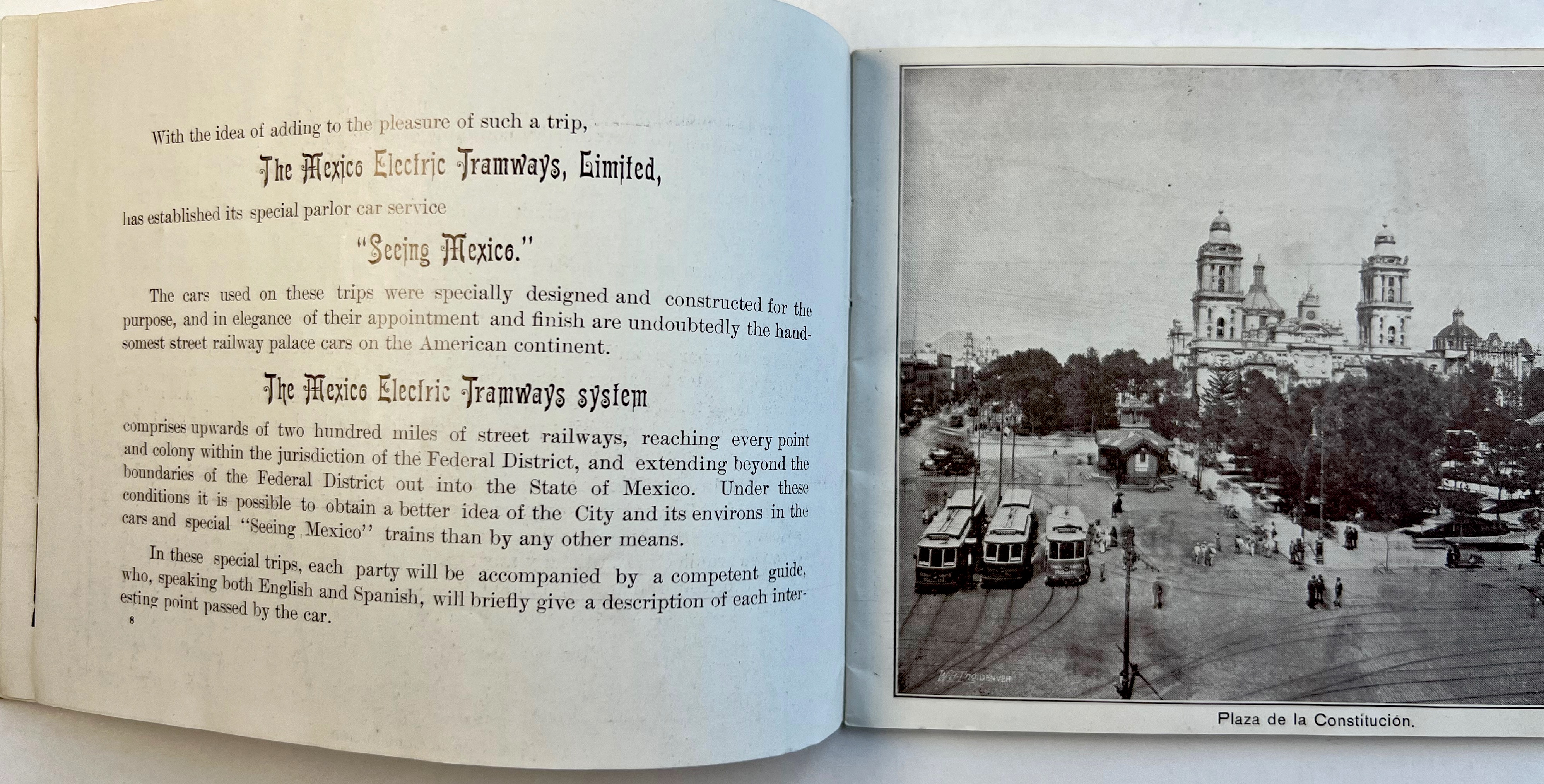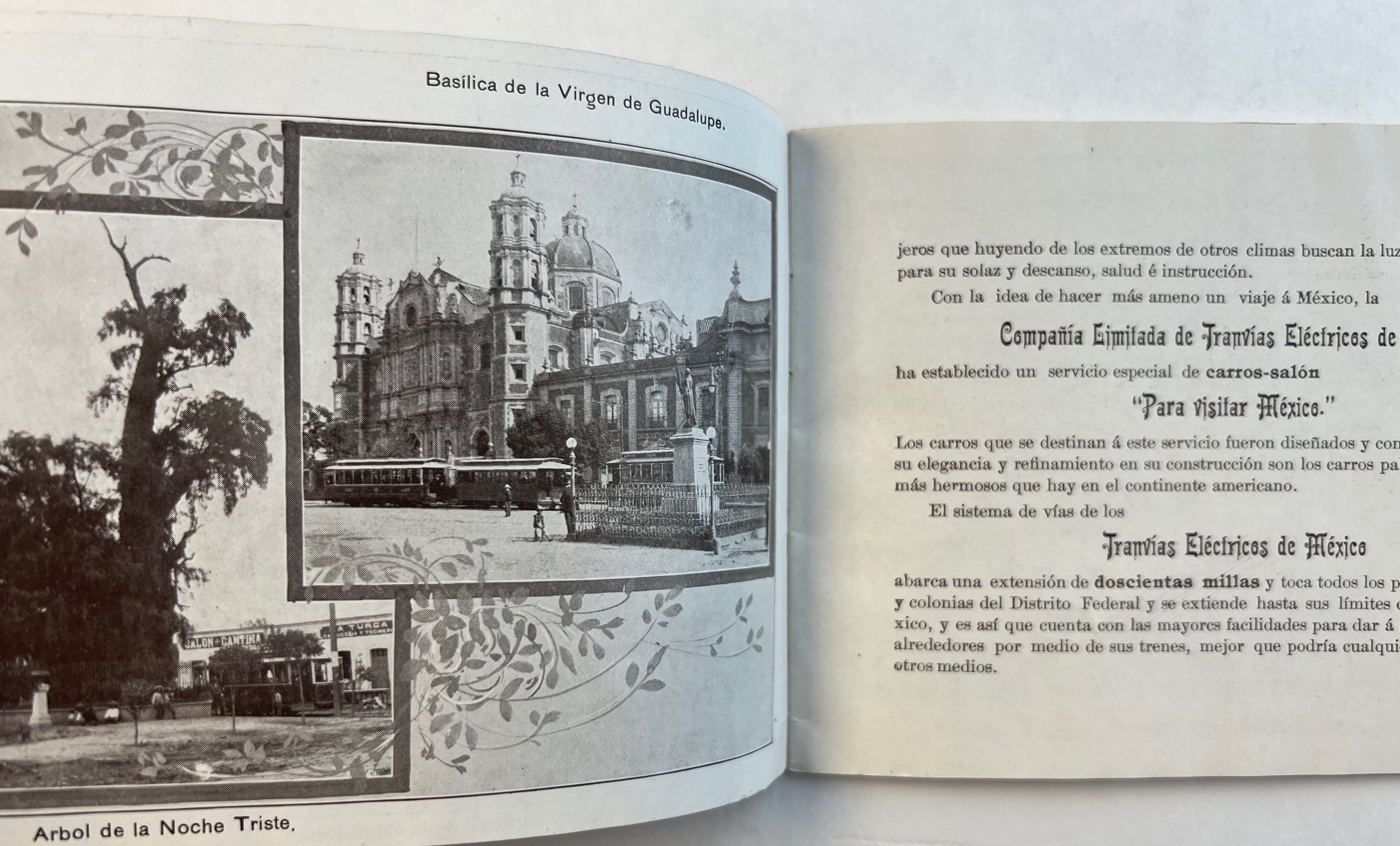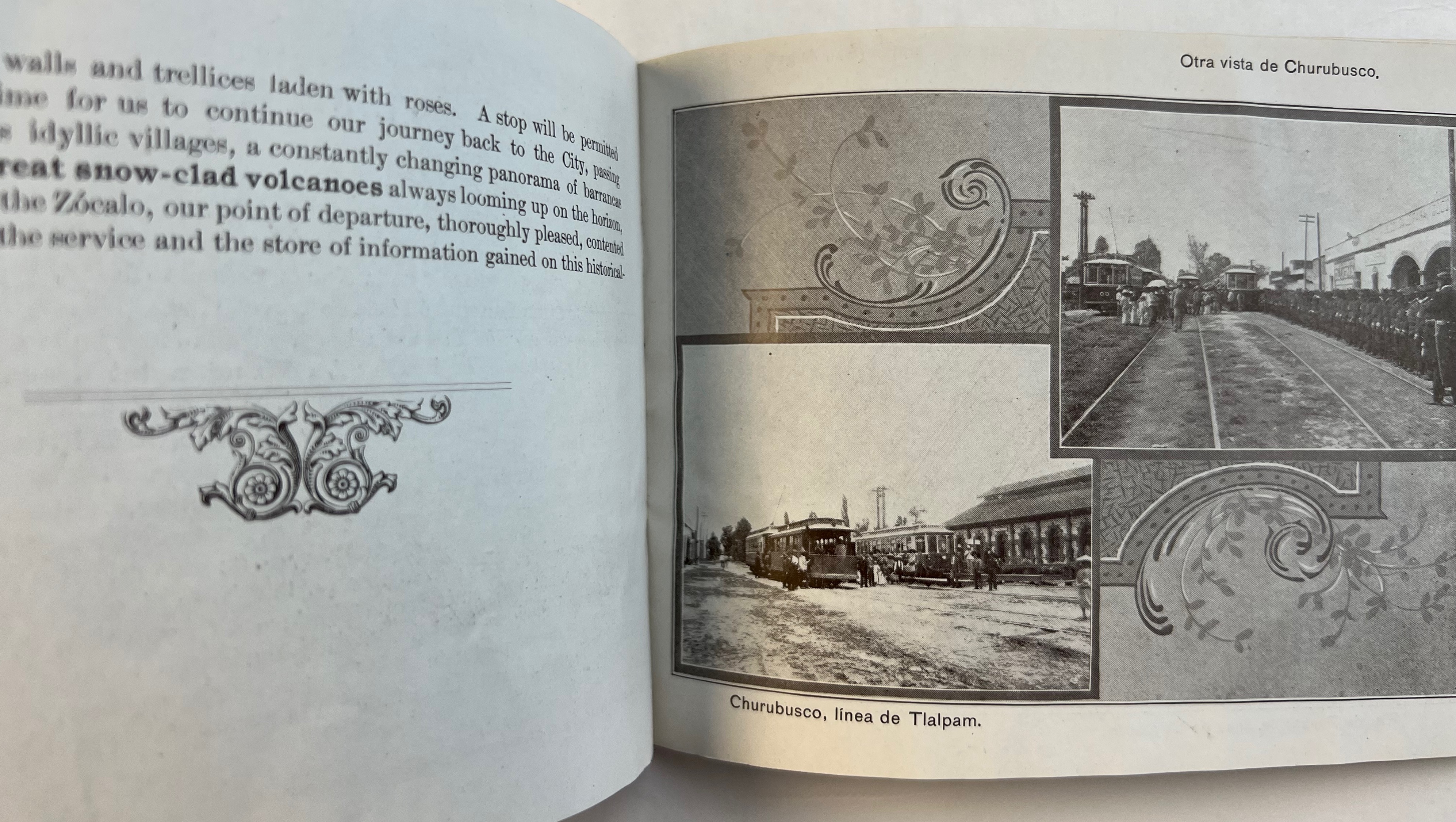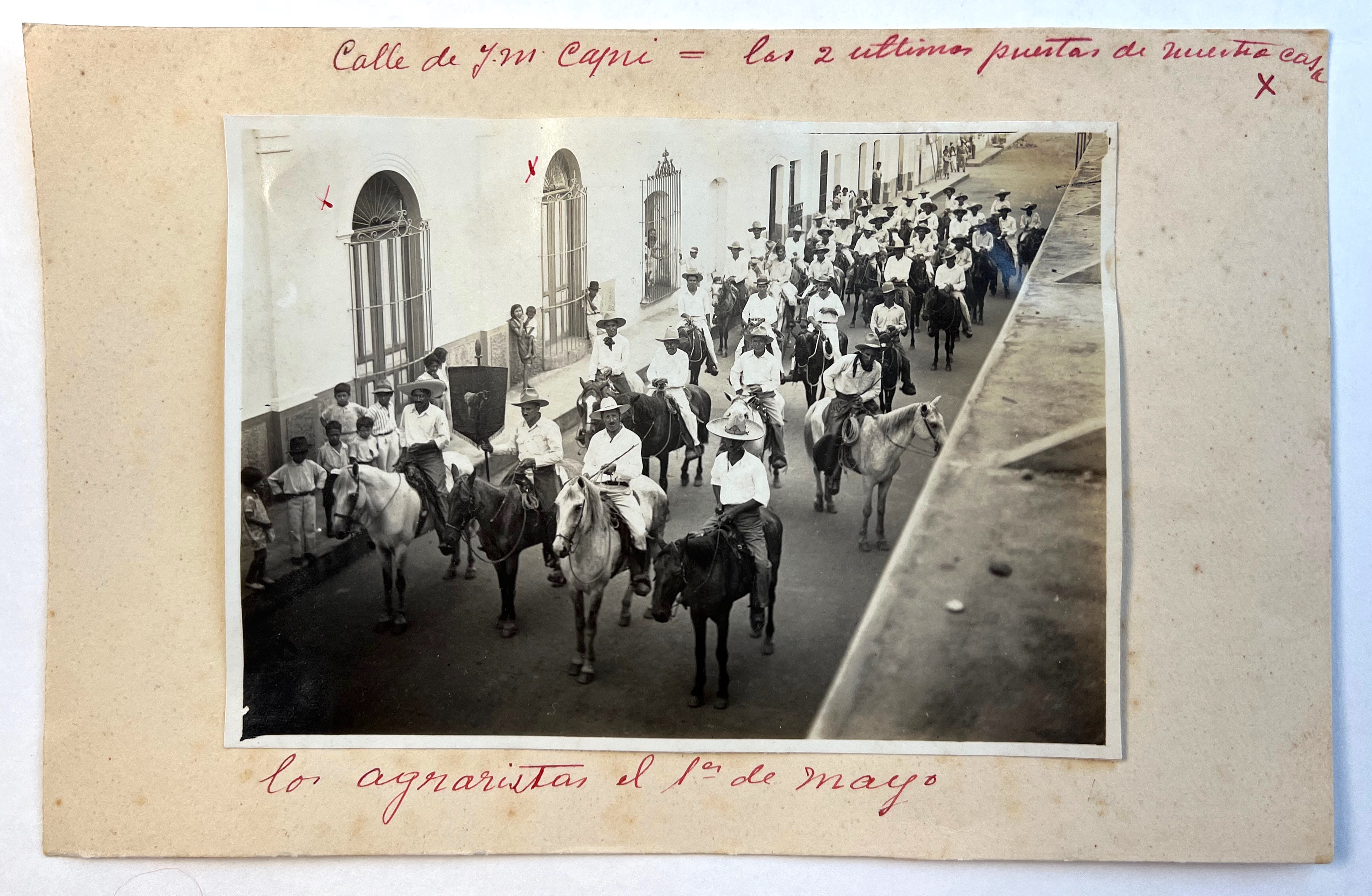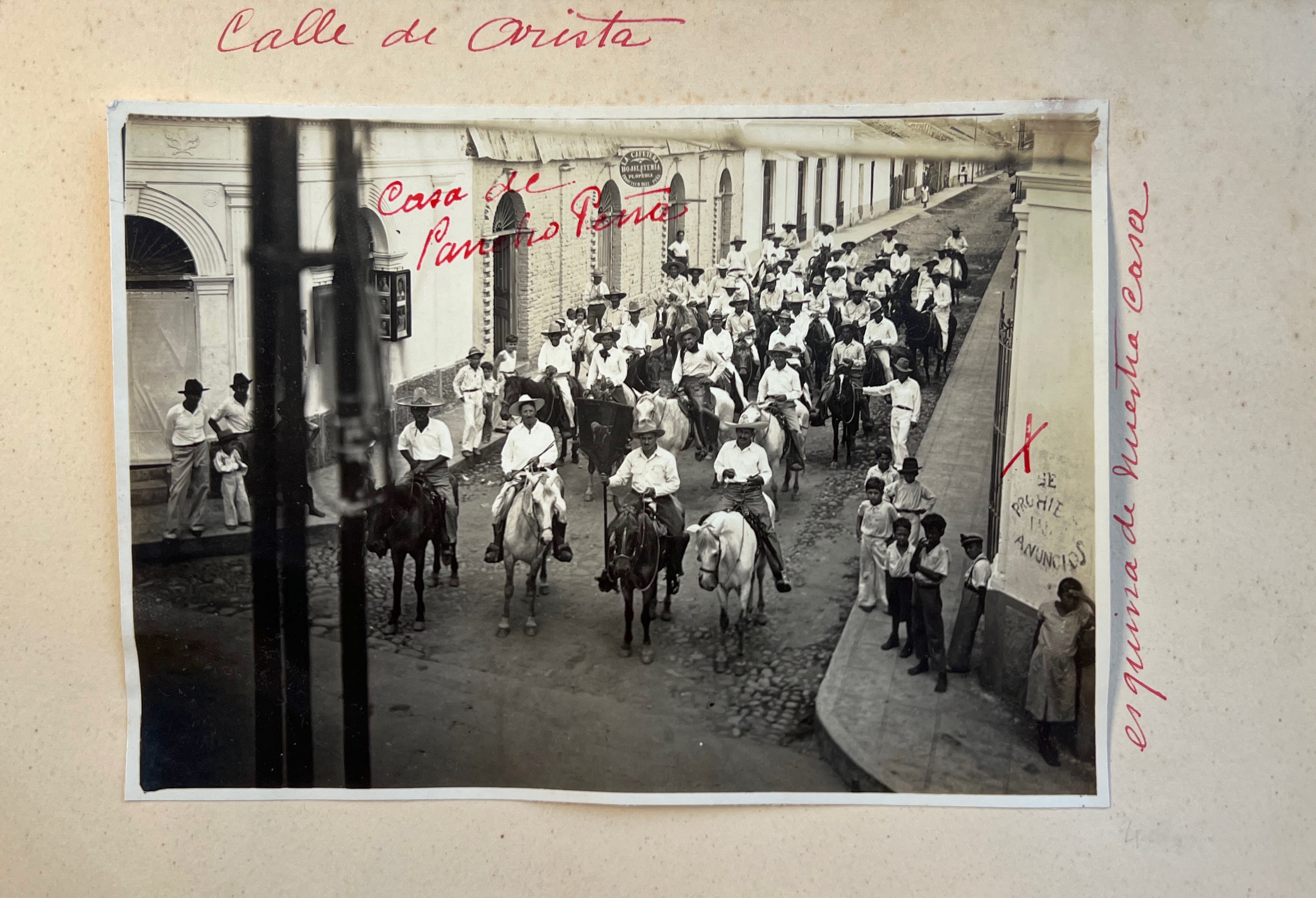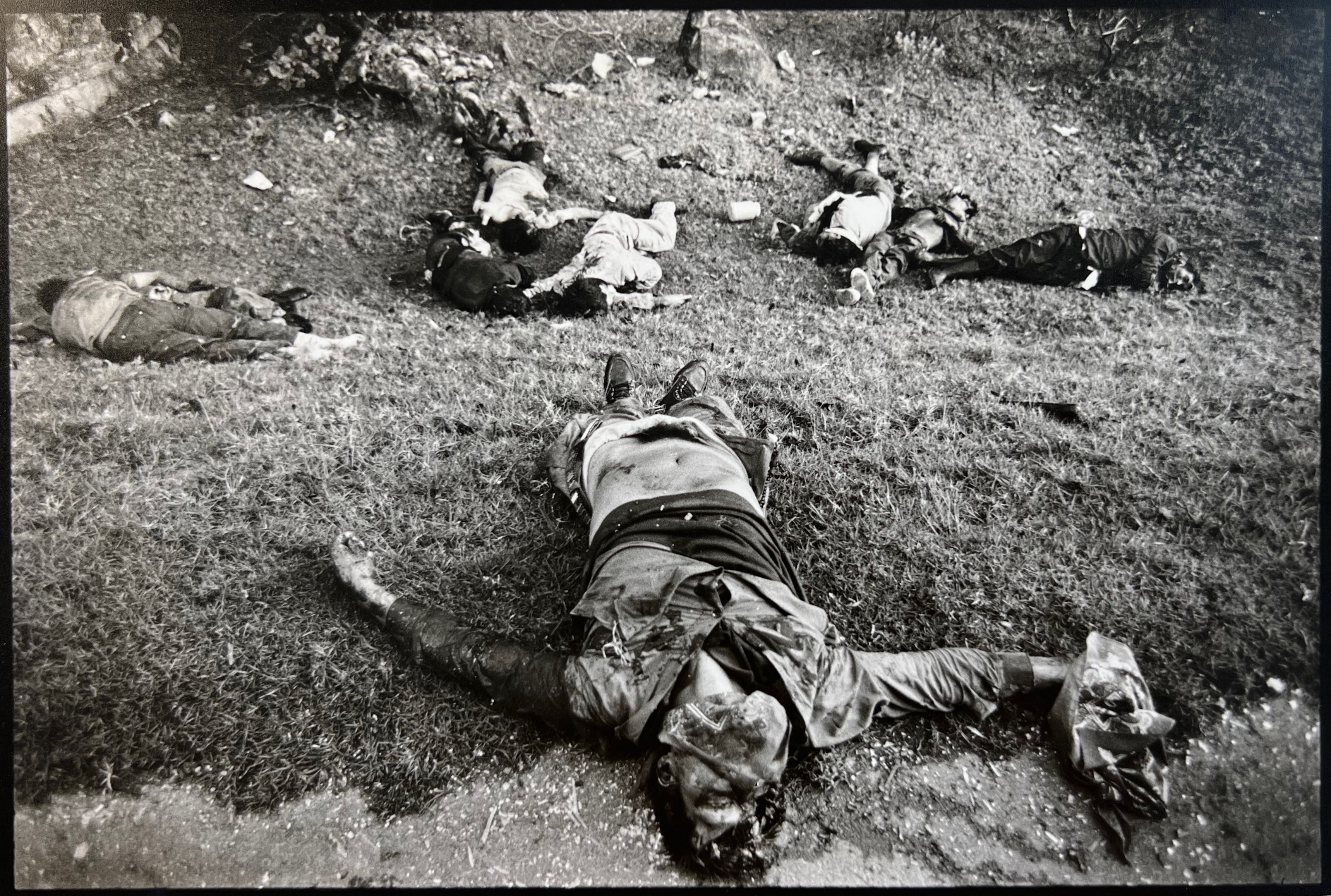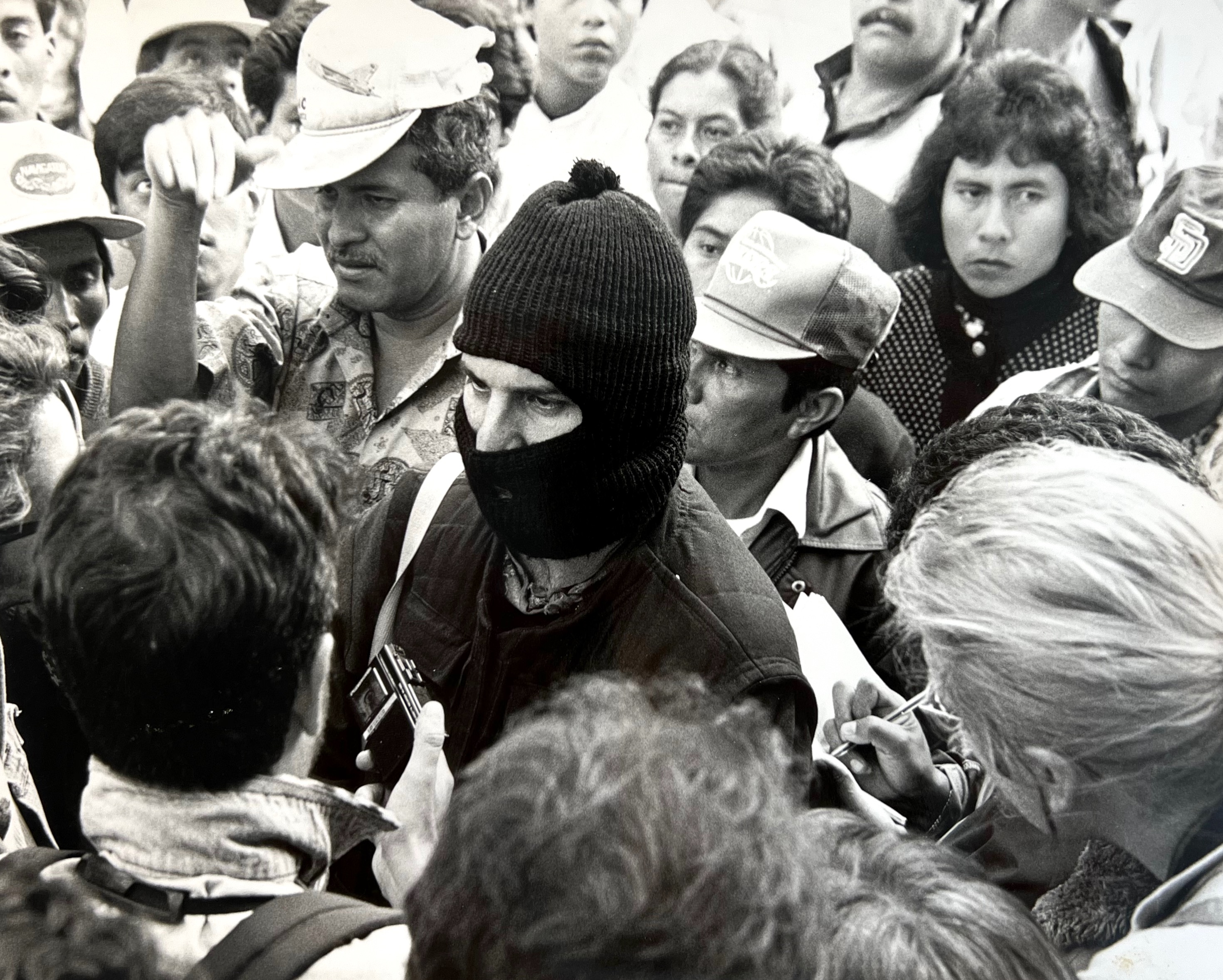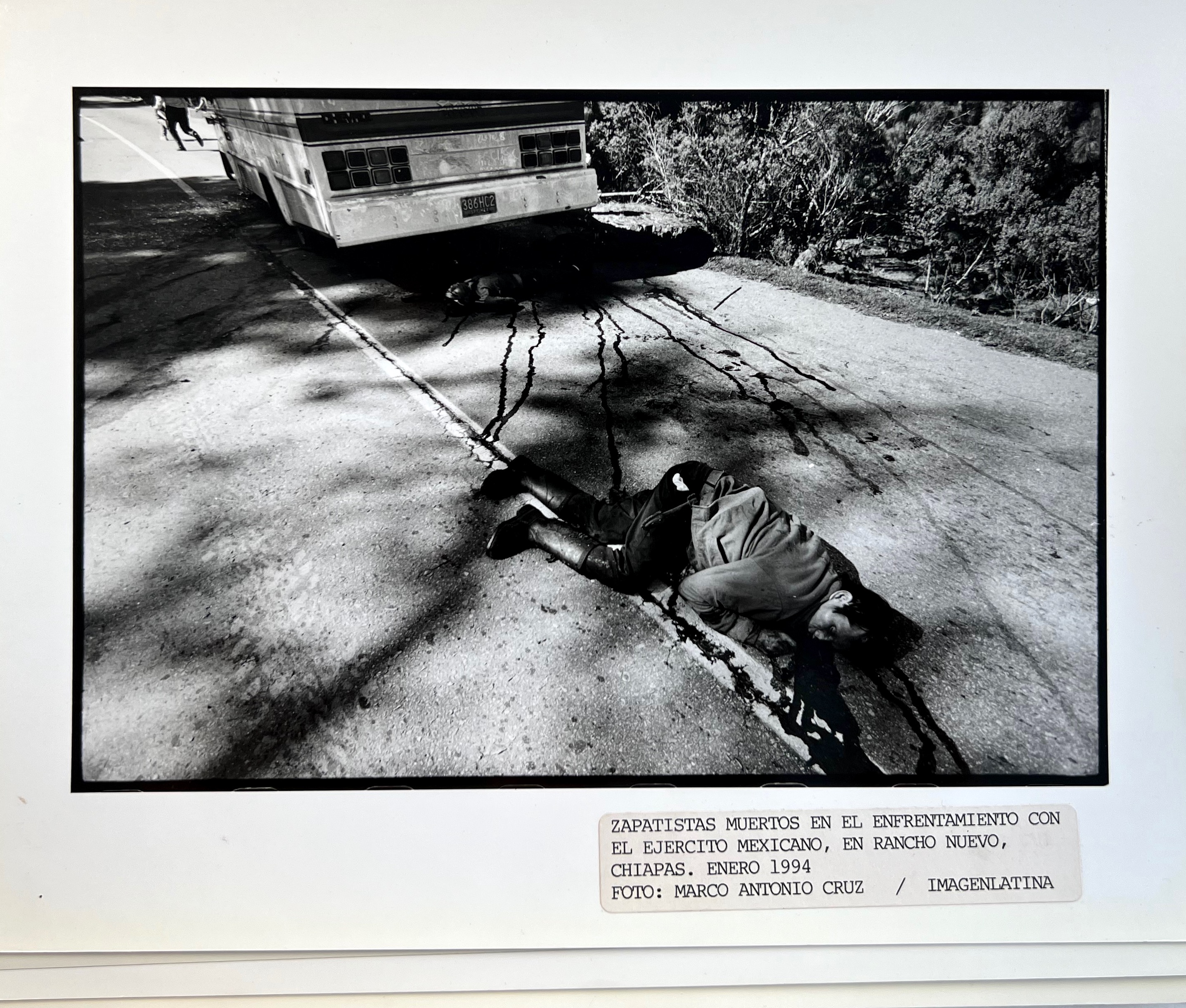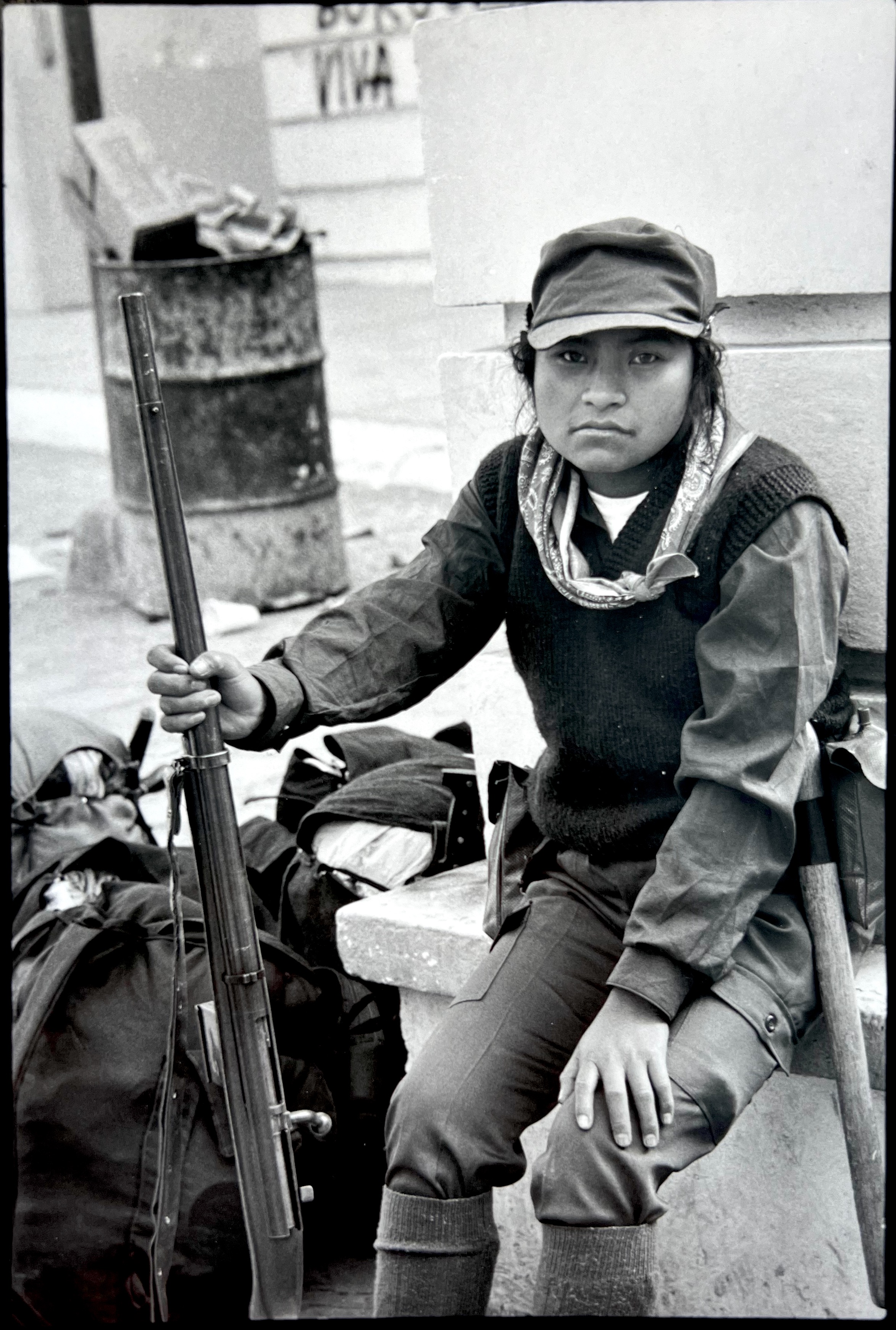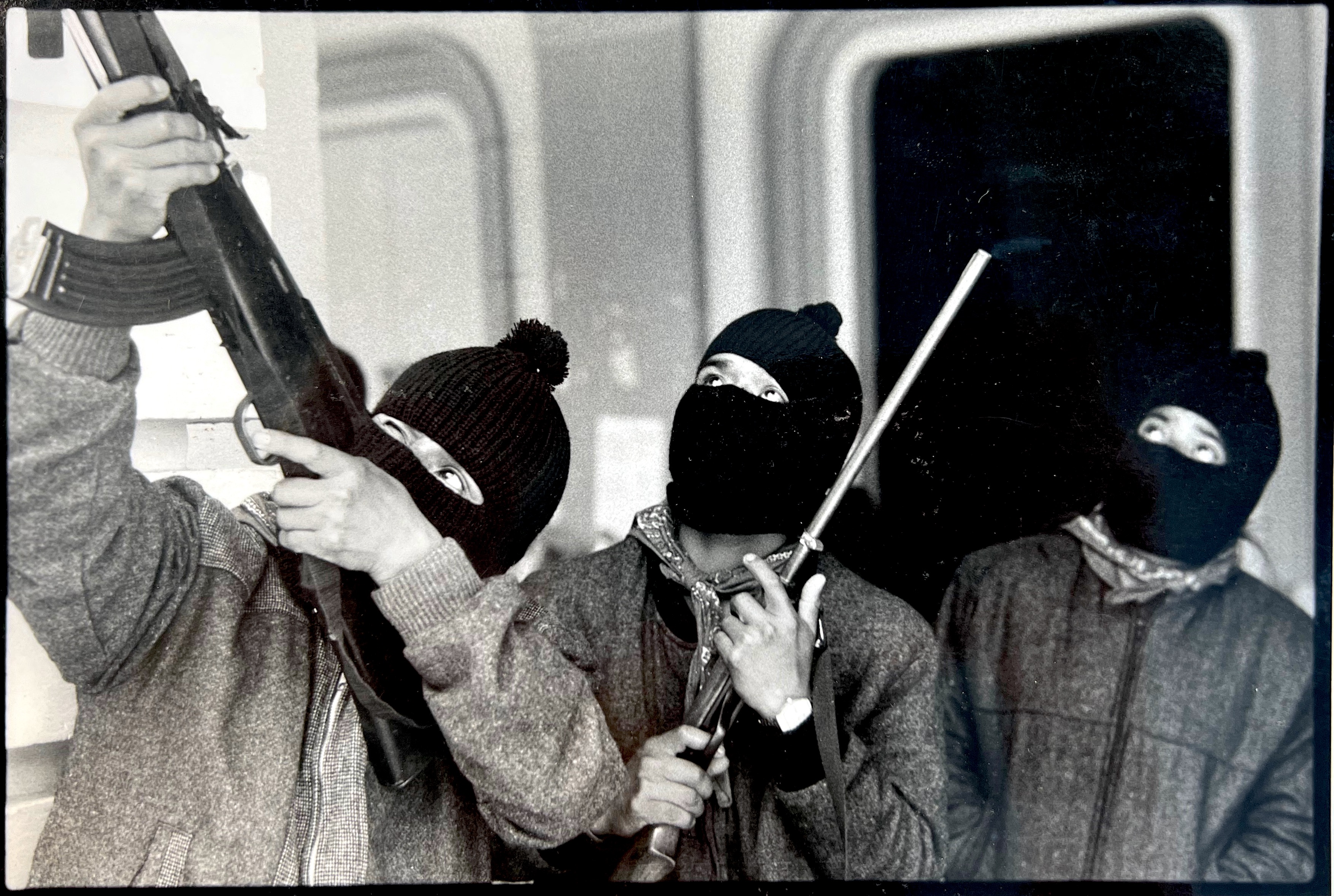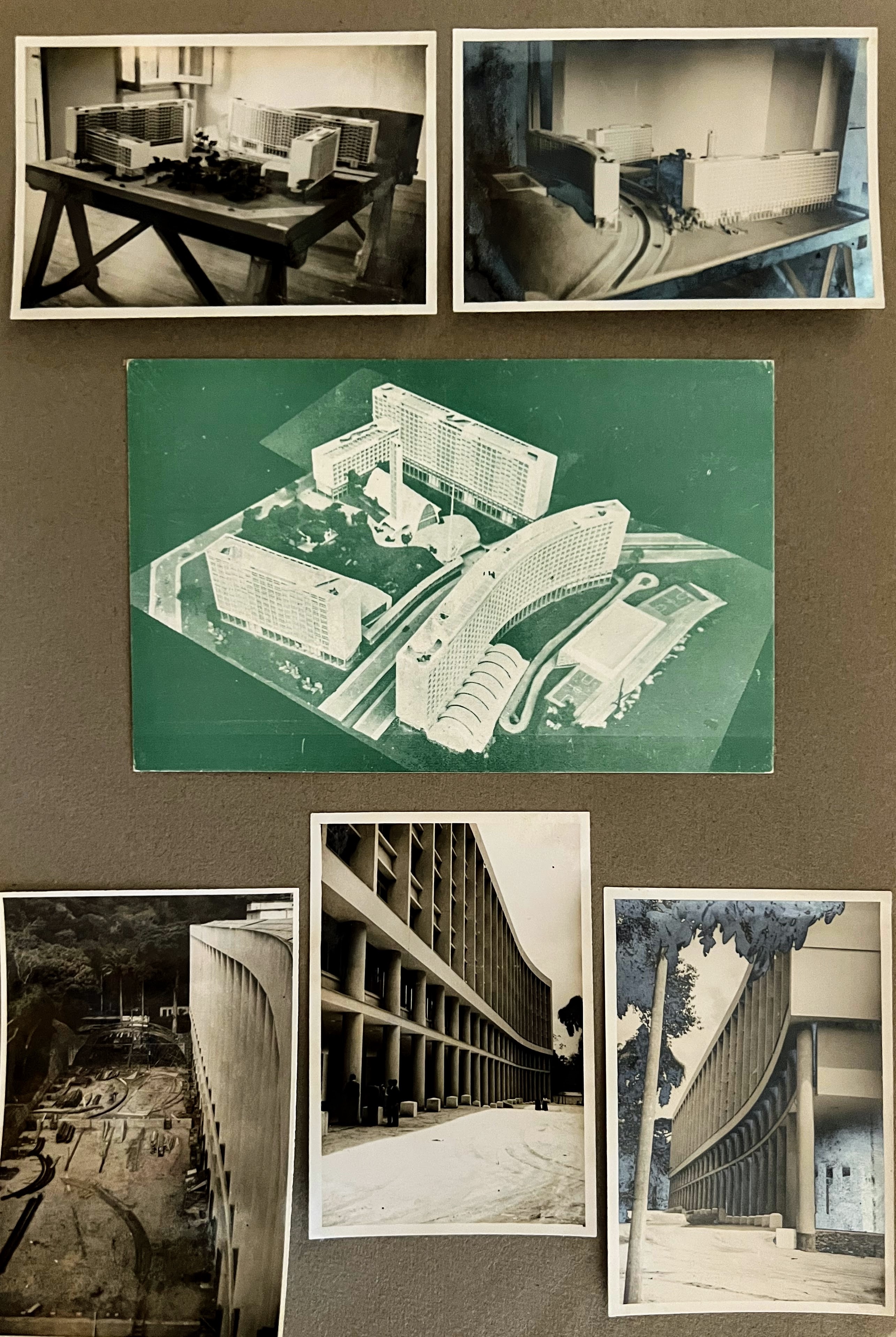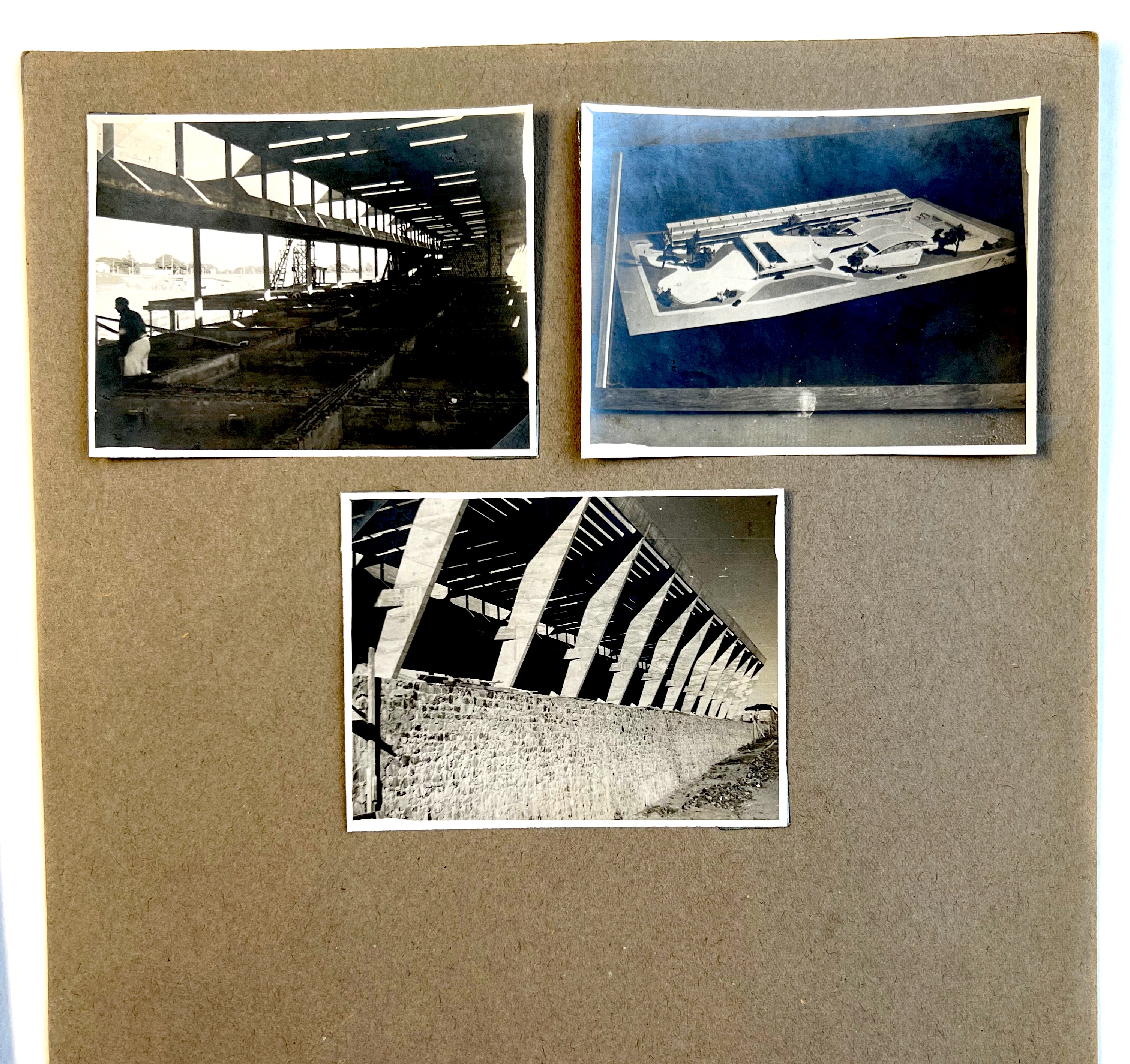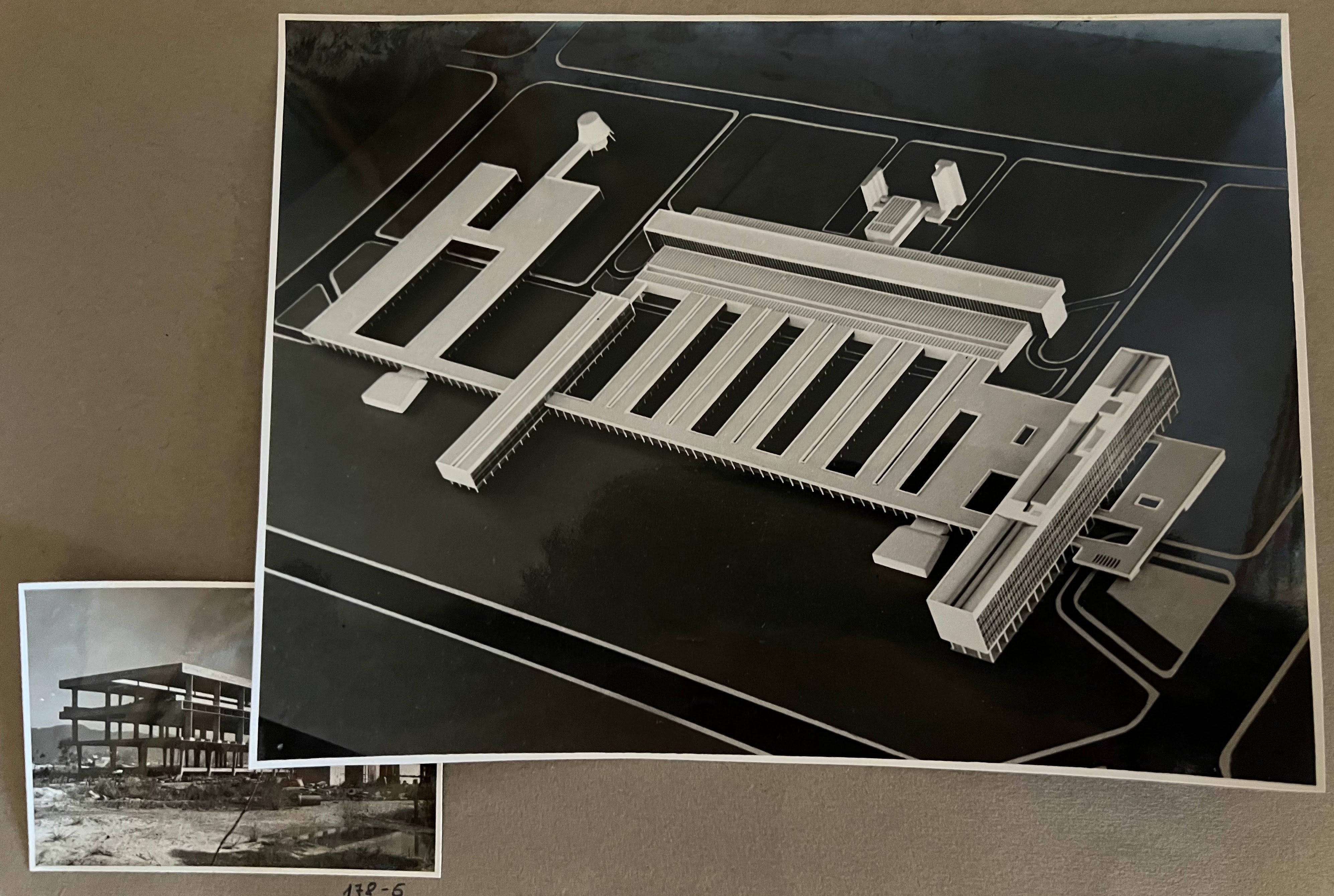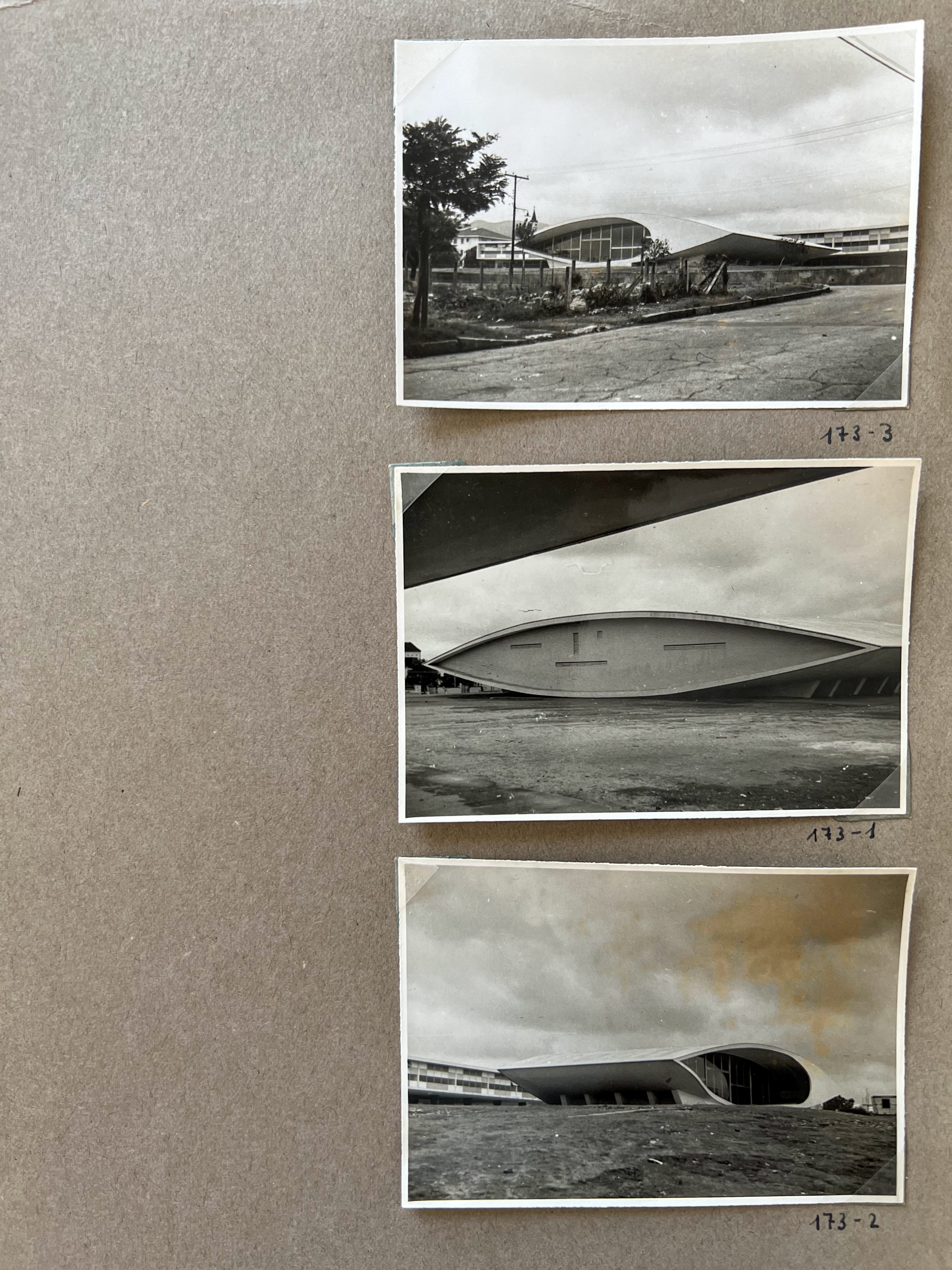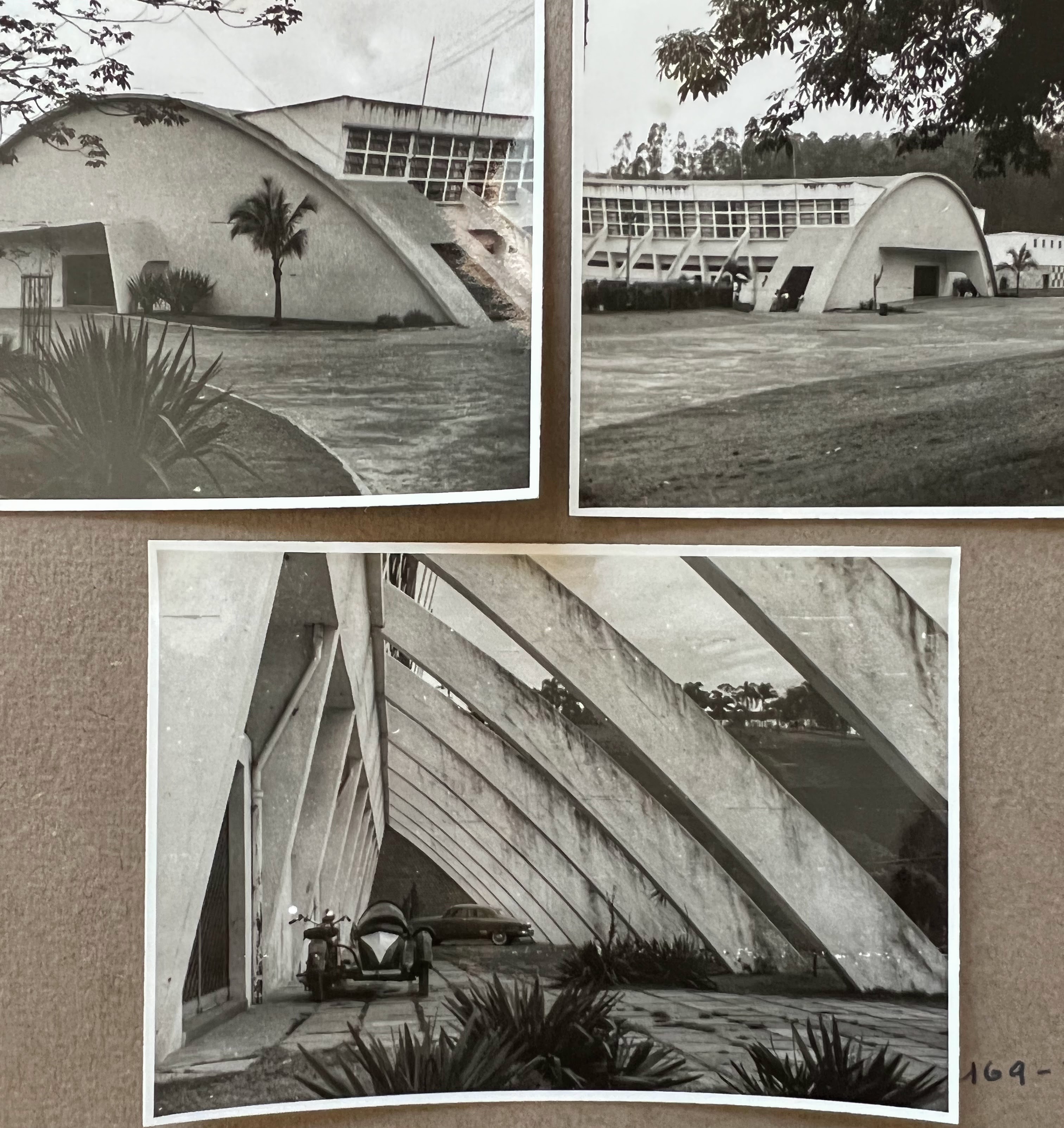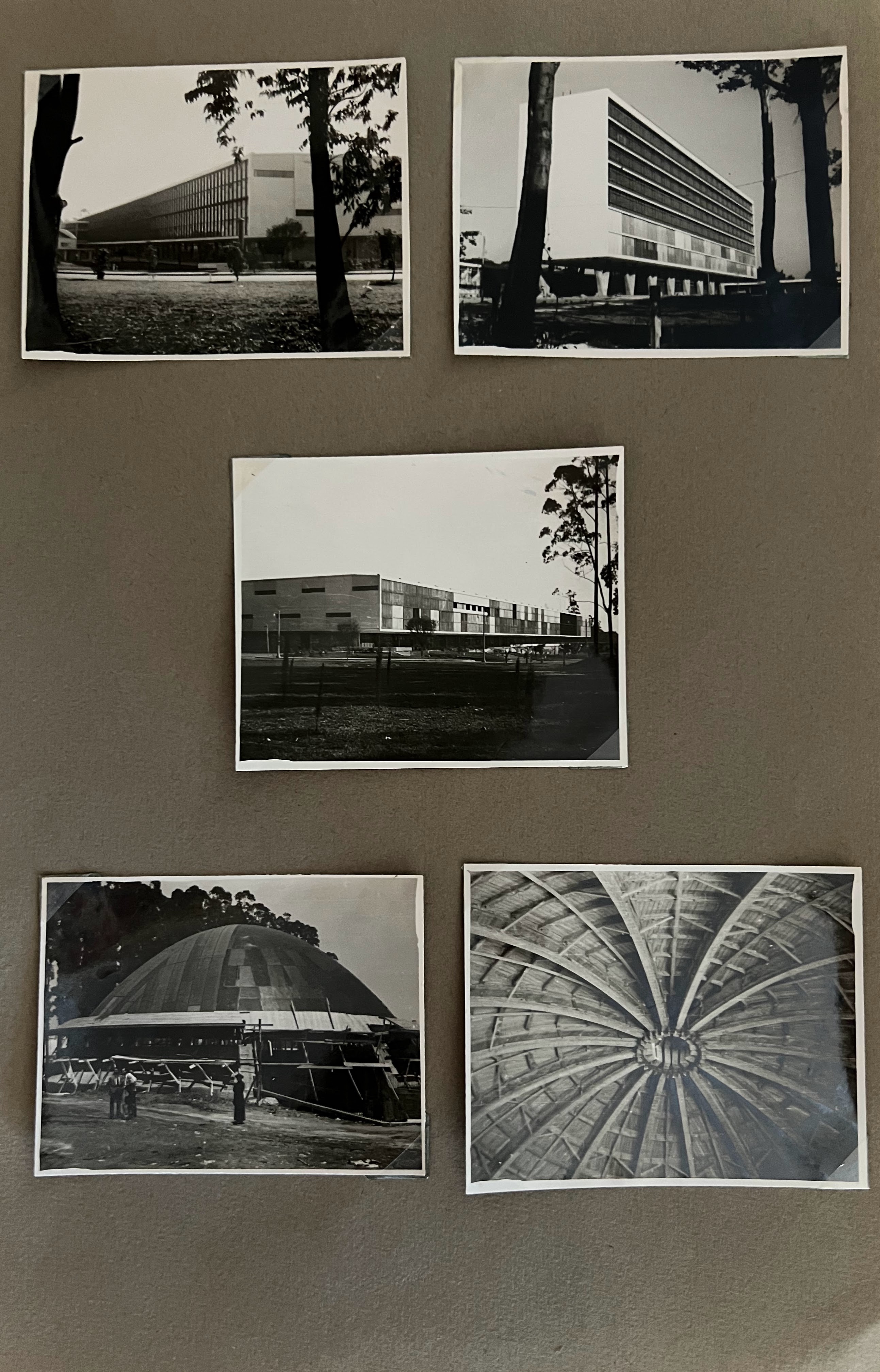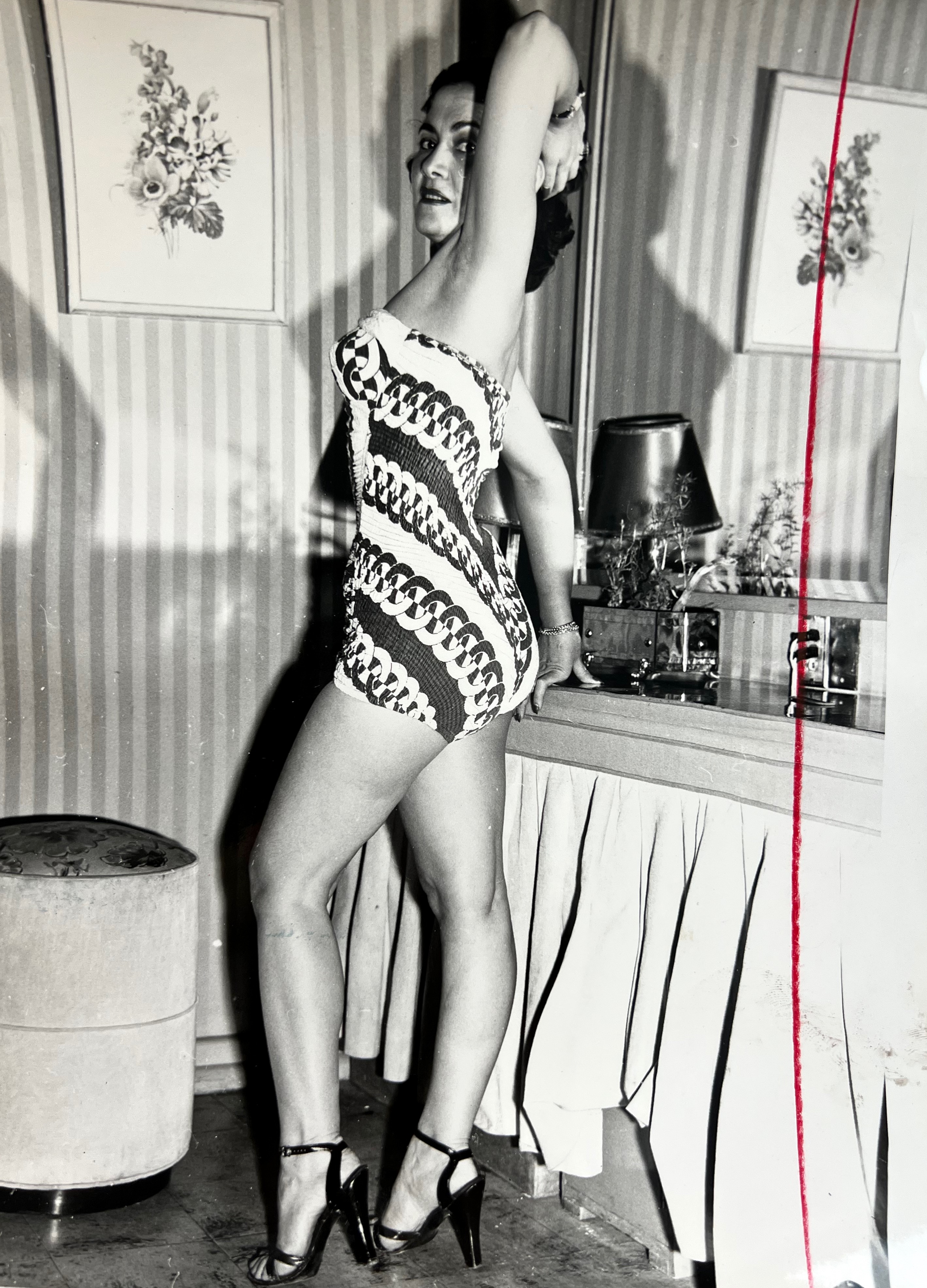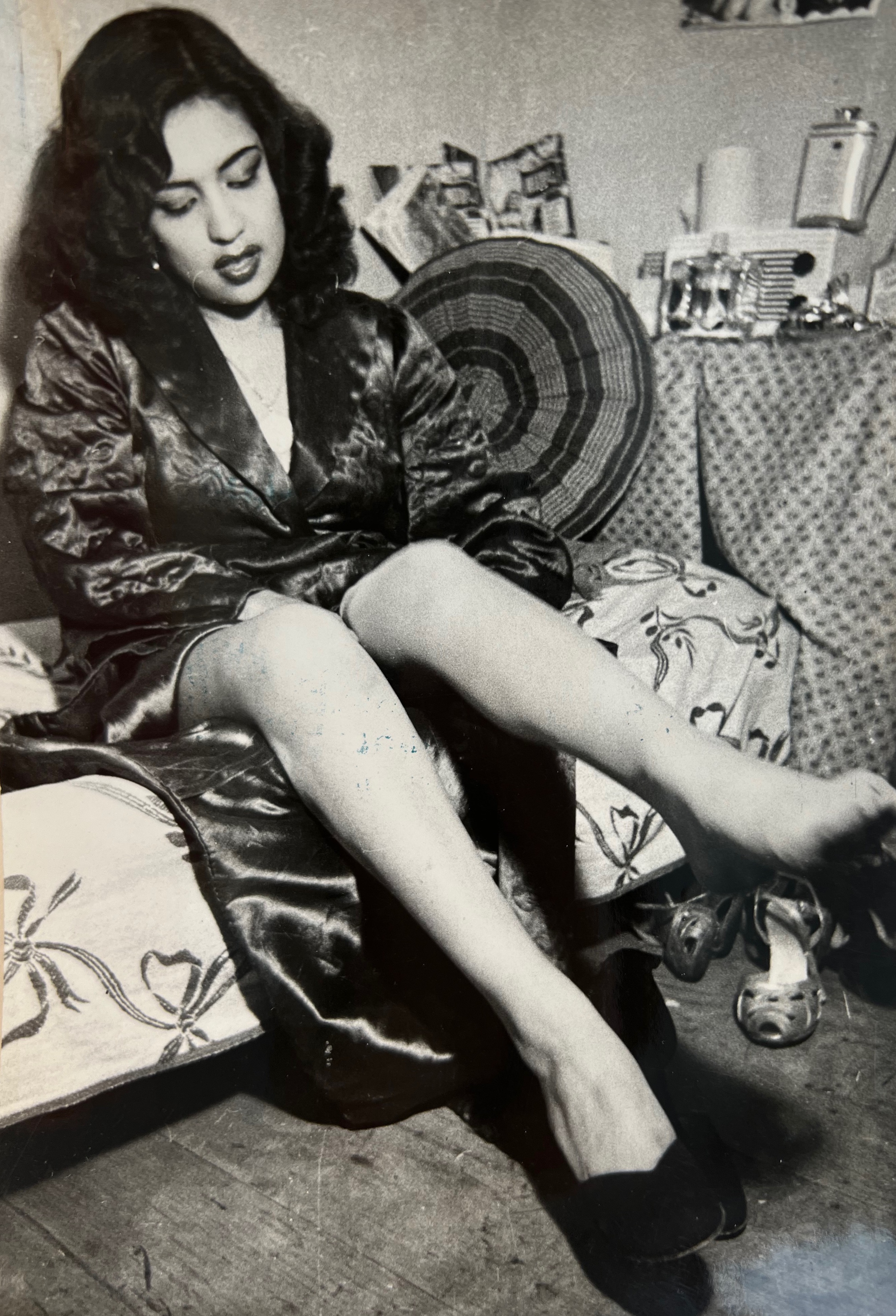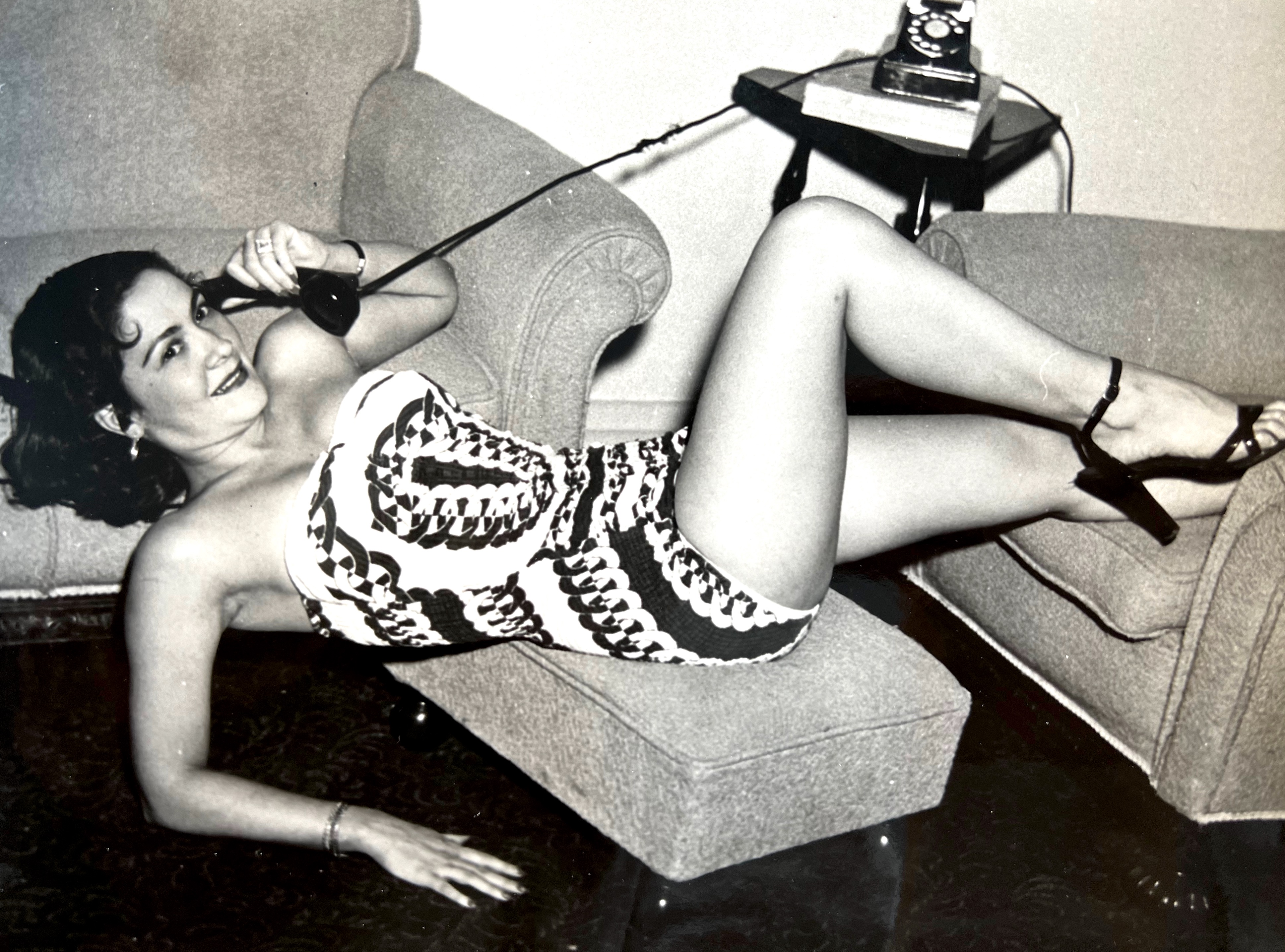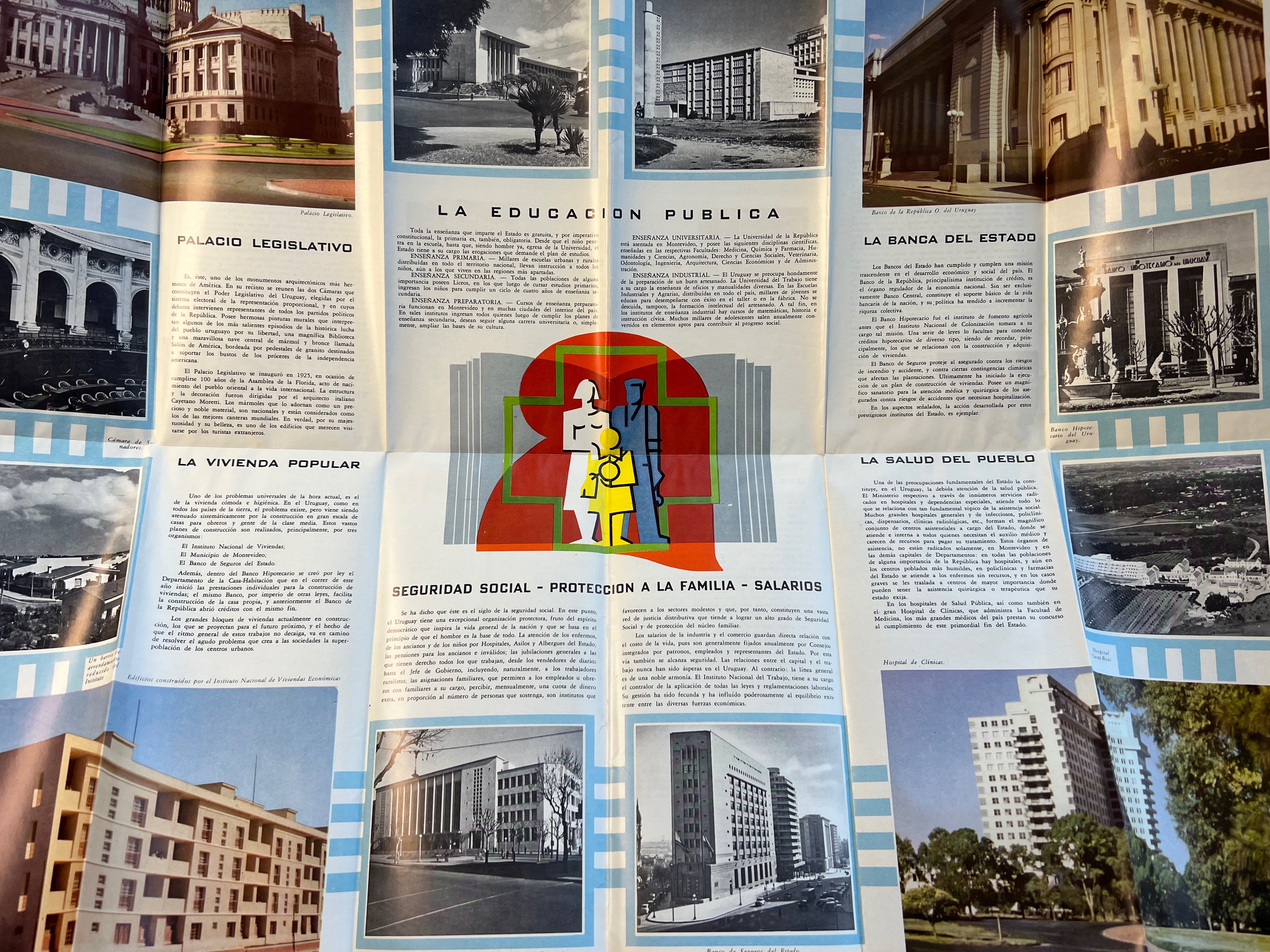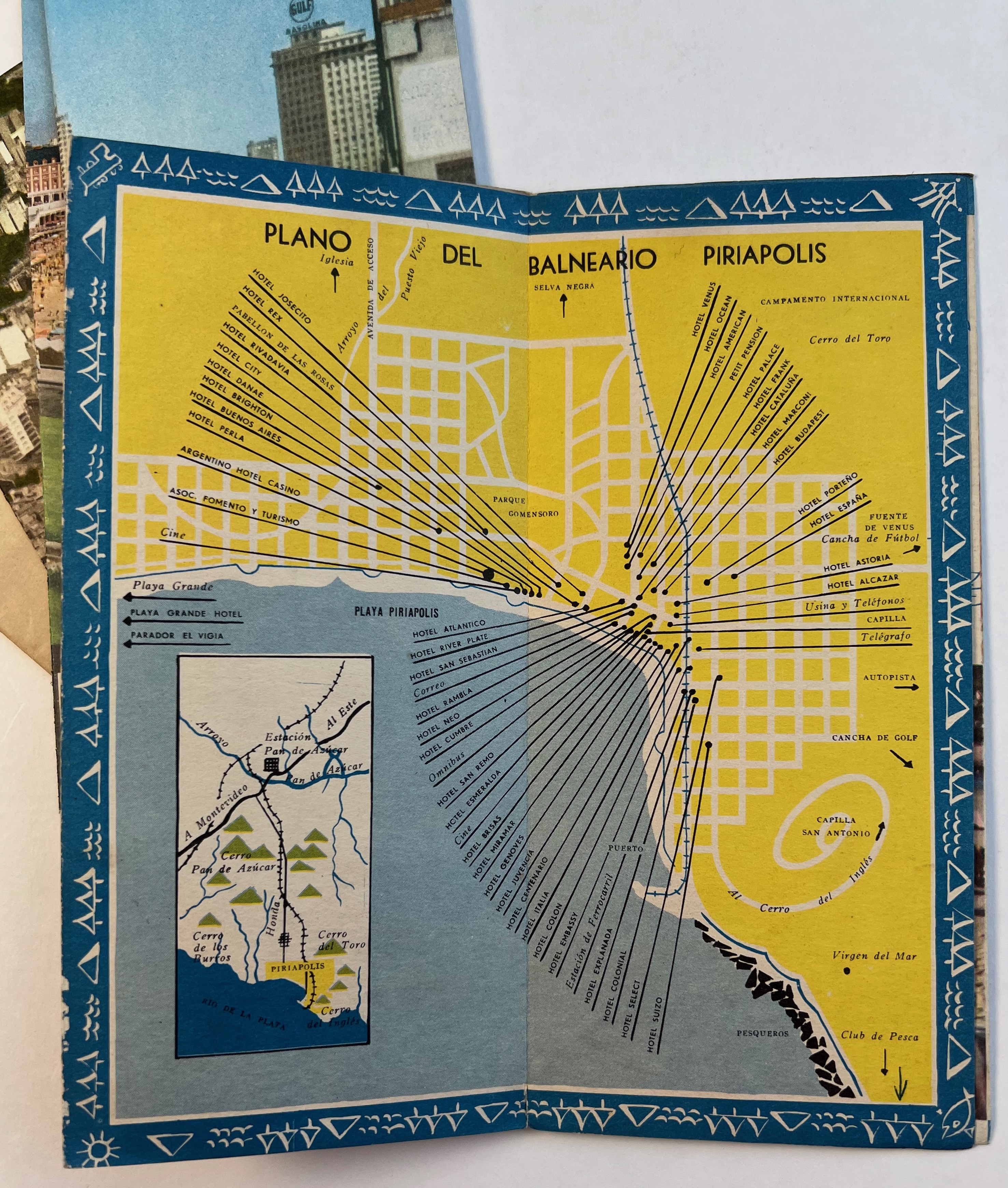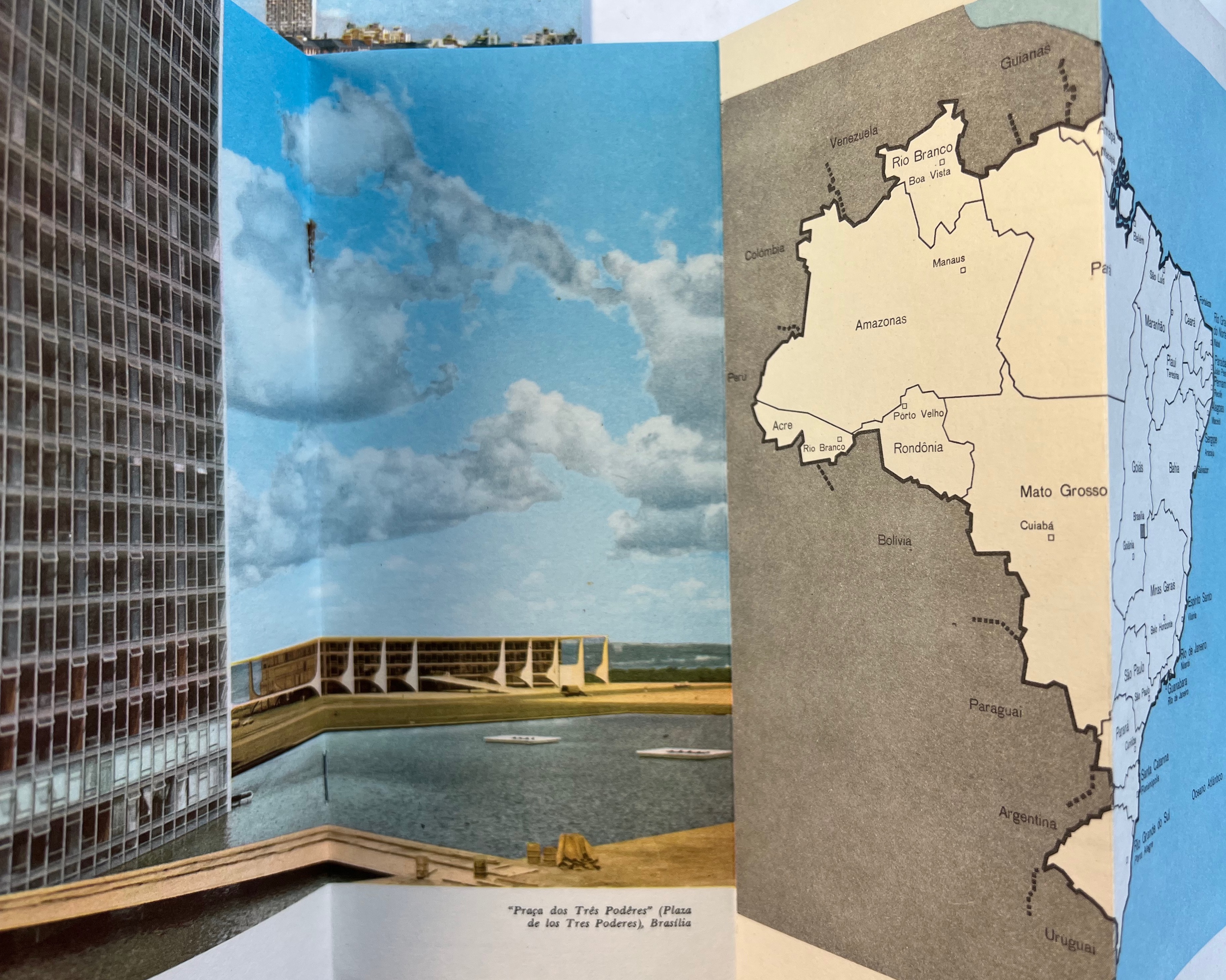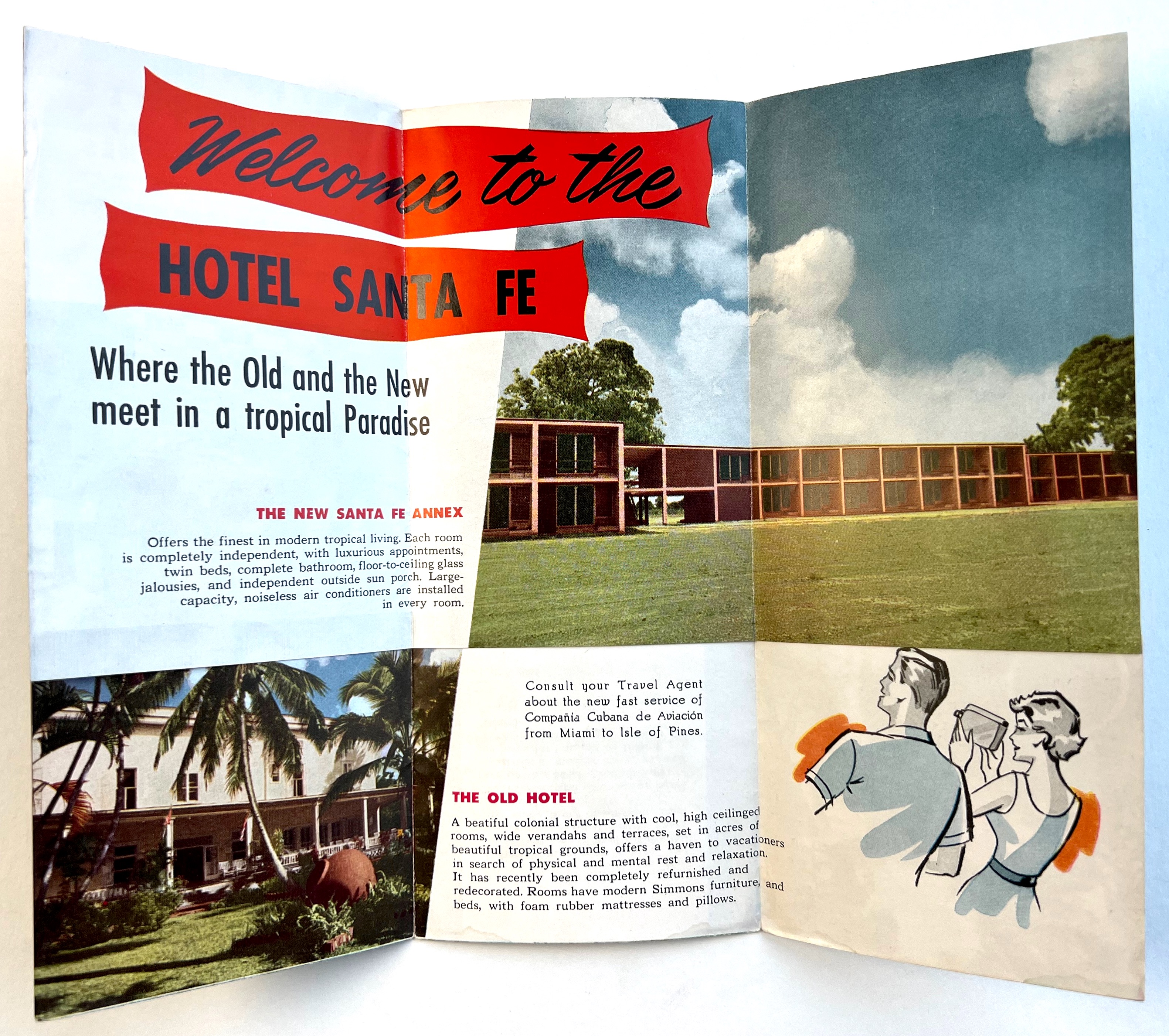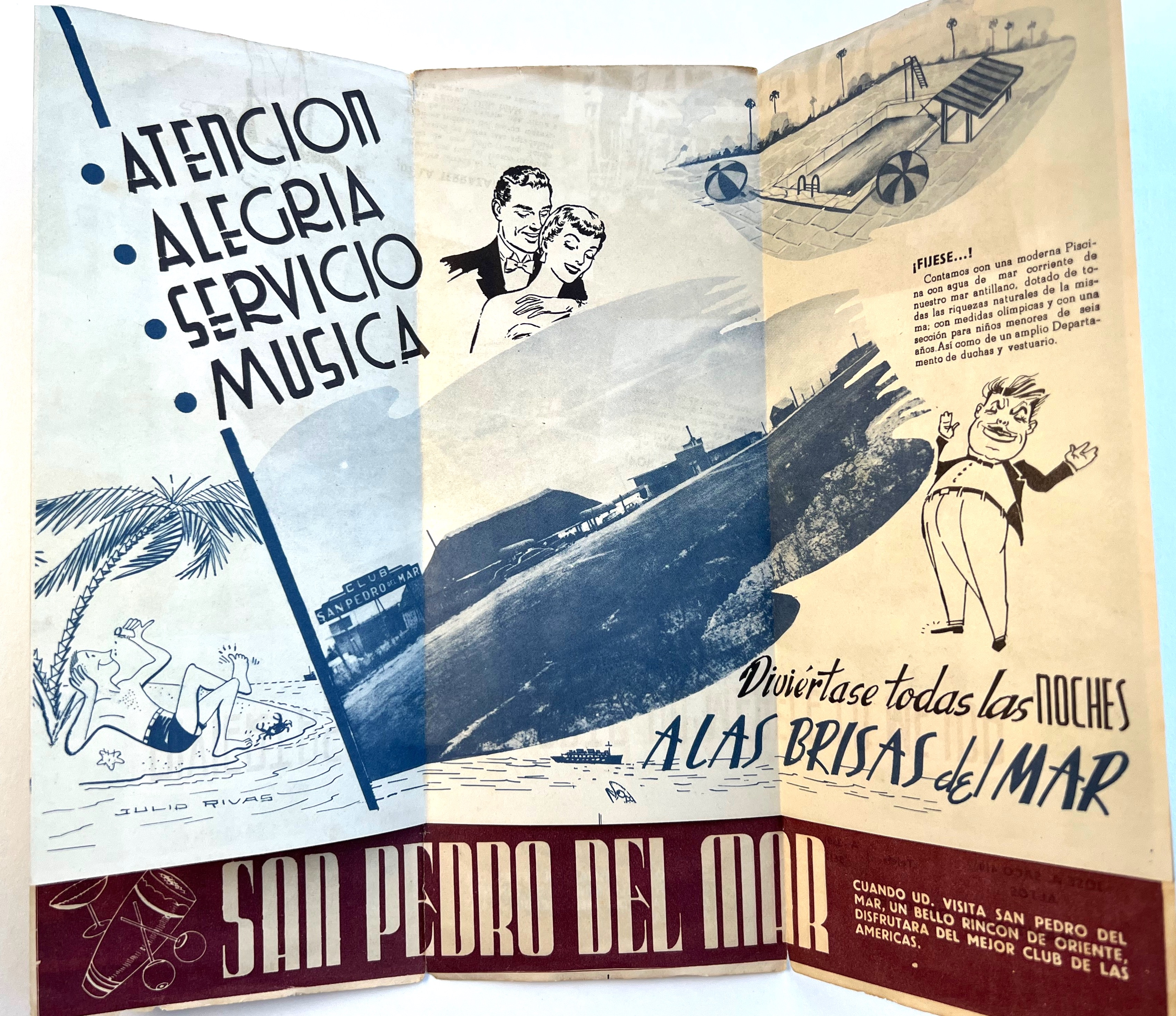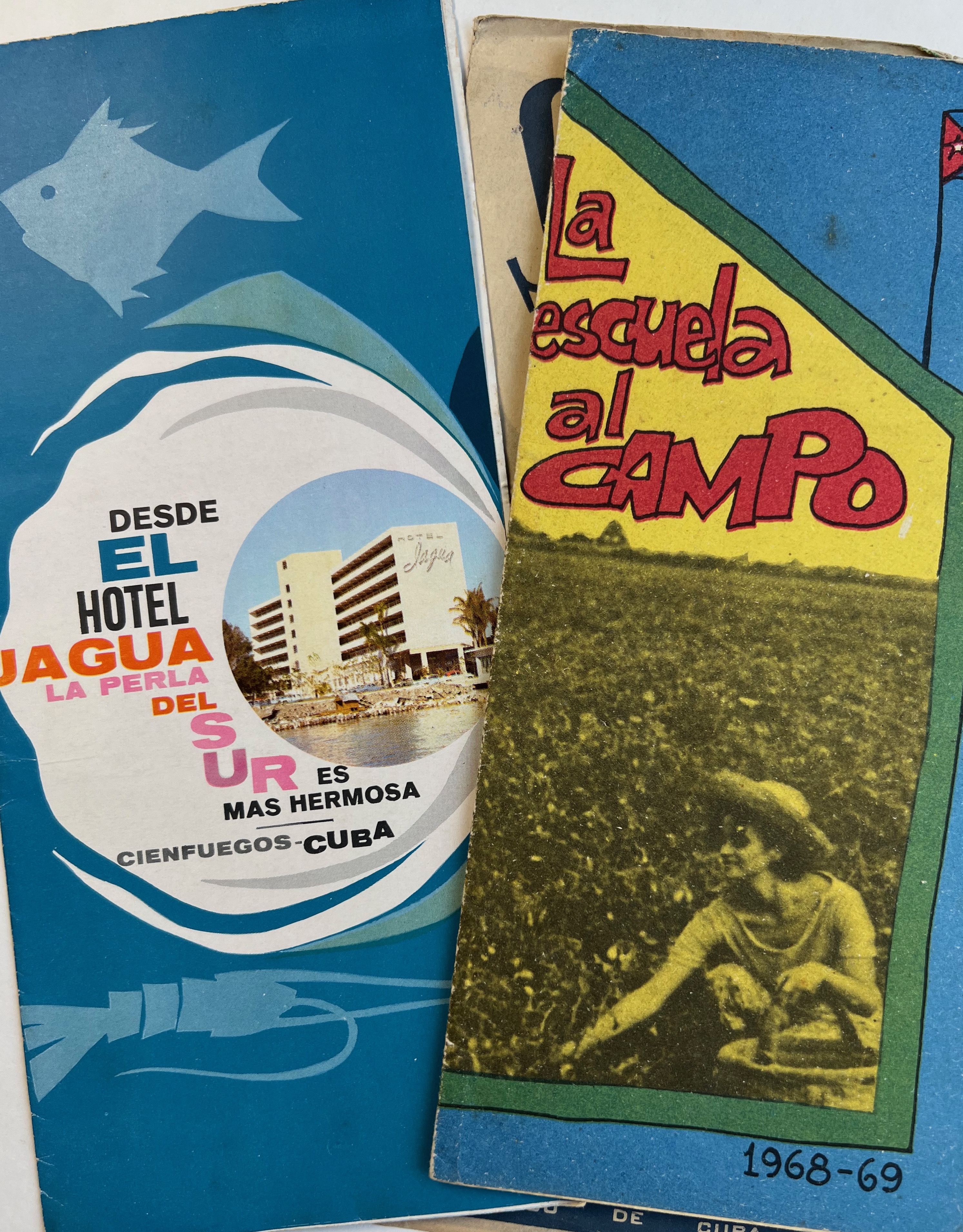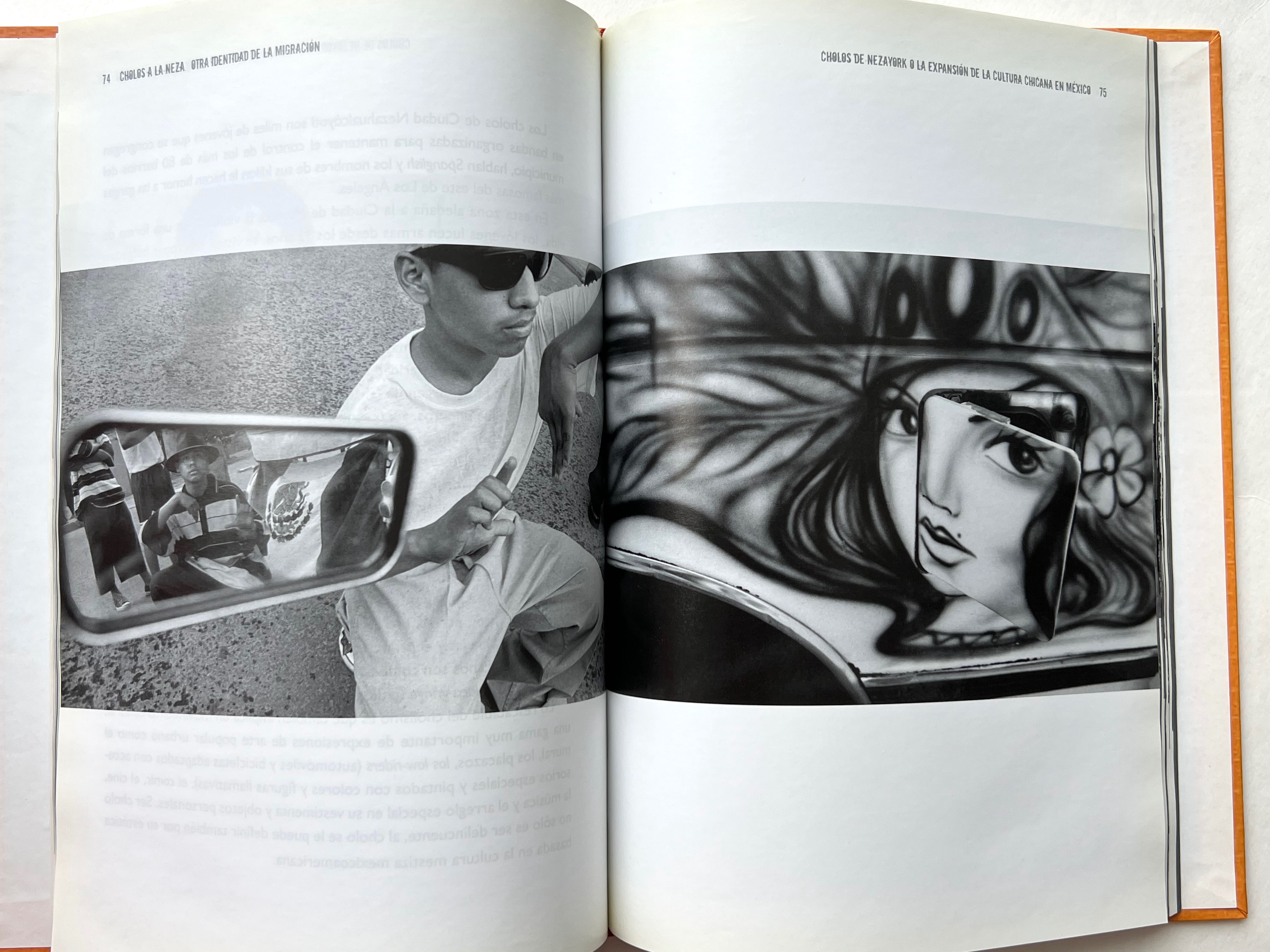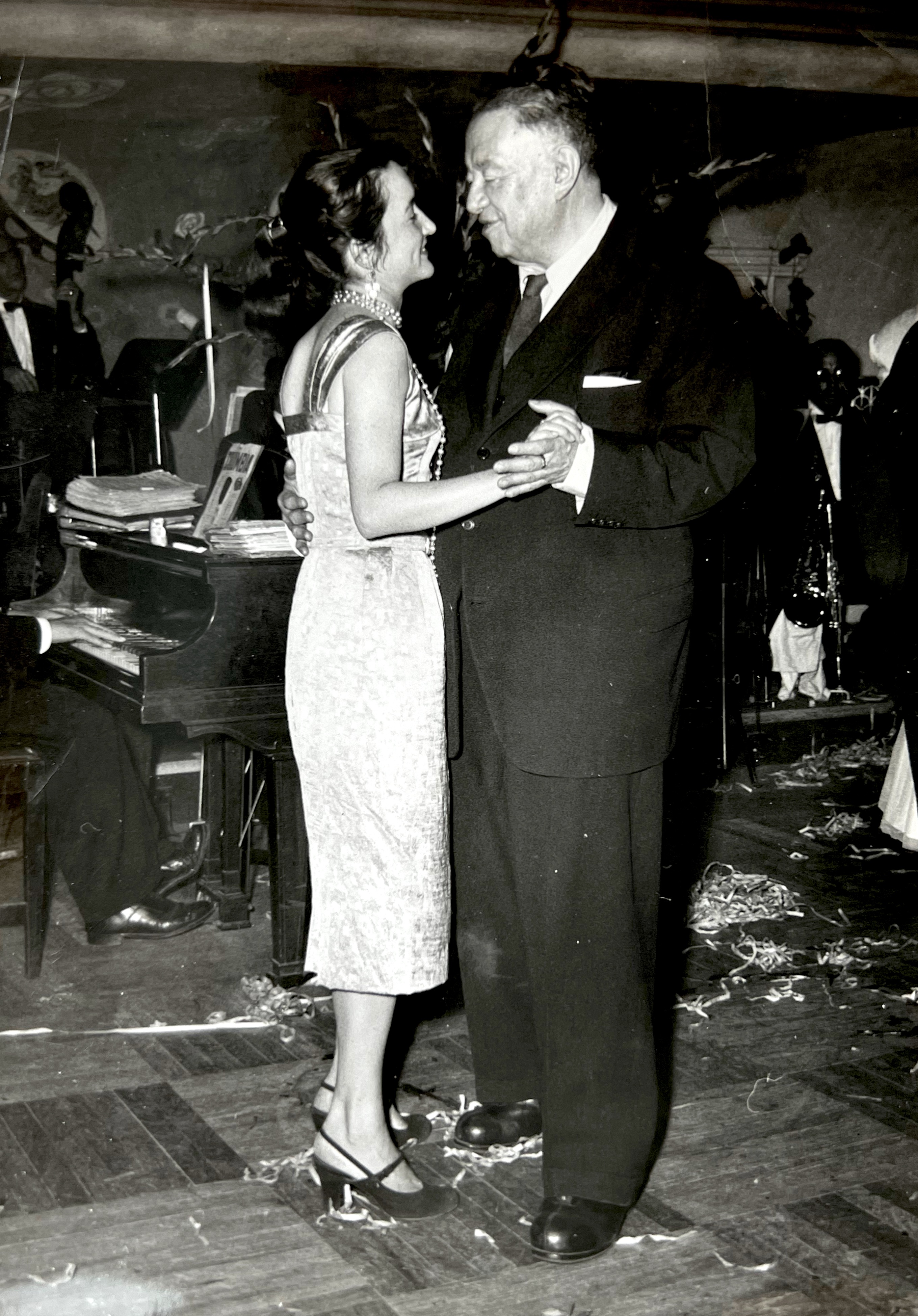GRAPH BOOKS: PRINTED MATTER FROM RADICAL ART AND SOCIAL MOVEMENTS.
FEMINIST HISTORIANS OF MATERIAL CULTURE.
Photobooks, Photography, and Ephemera
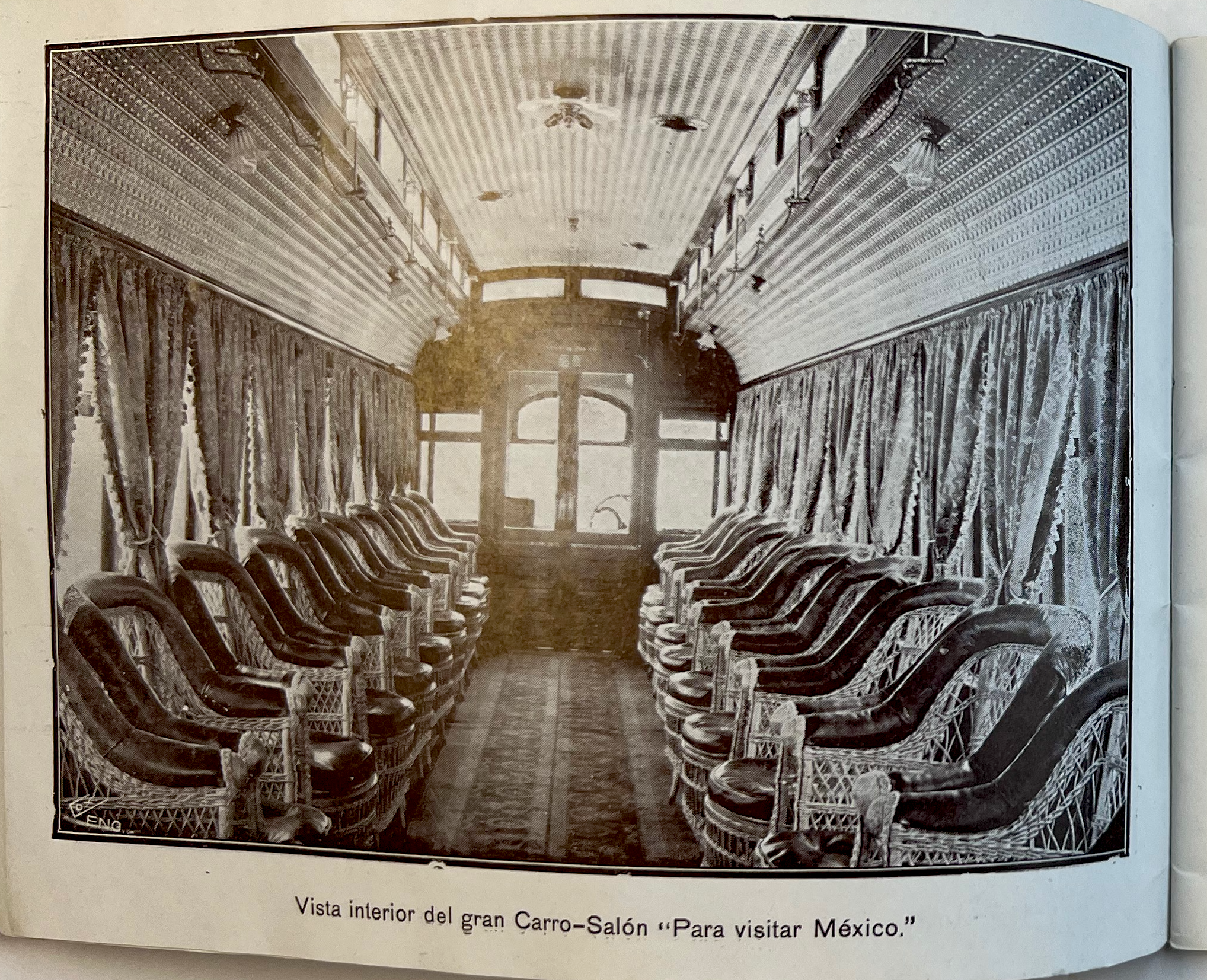
1907
(Tourism) (Railways) Promoting special guided parlor car service on Mexico City's new electric tramway.
(Tourism) (Railways) Promoting special guided parlor car service on Mexico City's new electric tramway.
Alrededor de México: Vista en los carros especiales de La Compañía Limitada de Tranvías Eléctricos
(Mexico) (Tourism) (Railways) Compañía Limitada de Tranvías Eléctricos de Mexico. Alrededor de México: Vista en los carros especiales de La Compañía Limitada de Tranvías Eléctricos de México. Mexico, D.F.: La Compañía, 1907. Oblong 14.7cm, 37, [2], pp.; 13 b/w pls. with captions; stapled brown paper wrappers, a bit thumbed, printed with “Obsequio La Compañía Limitada de Tranvías Eléctricos de Mexico” recto, “Compliments of…” [same] verso. Very Good.
Bilingual, early guide to exploring Mexico City by rail on the special parlor car service of the Mexico Electric Tramway system. These special cars make two trips daily and will be accompanied by “competent” guides to describe the sights. “Every foot of ground covered in these trips is replete with a constantly changing panorama of historical interest, combined with pleasure and romance.” Detailed trip itineraries are listed with schedules. Special cars can also be chartered! Other electric and animal-driven tram lines listed with points of interest for the tourist.
Rare, a single holding listed in OCLC: UC-Berkeley.
$450
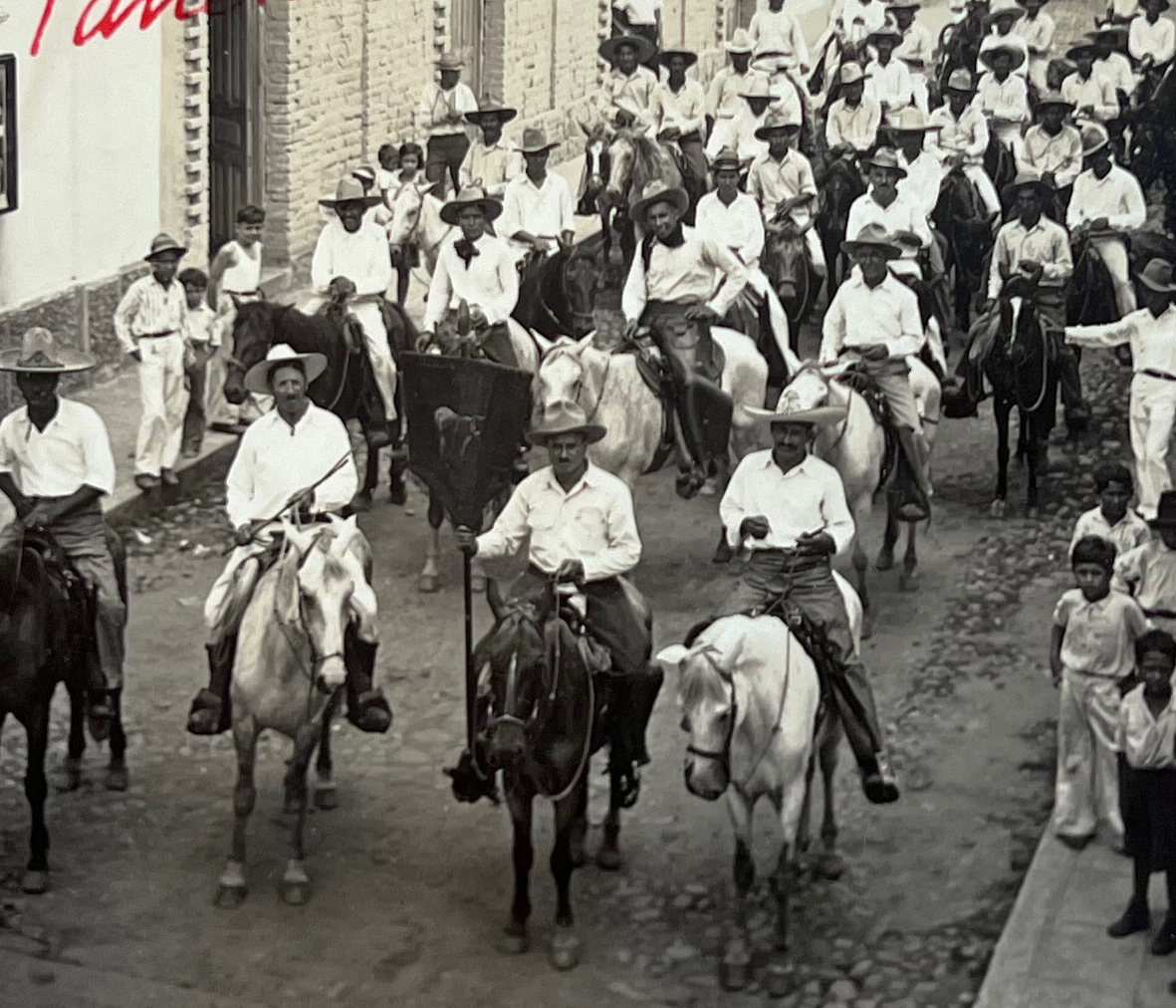
ca. 1920s
Photographs of a Mexican peasant movement action.
Photographs of a Mexican peasant movement action.
Two Photographs of Los Agraristas de 1o de Mayo
Two Photographs of Los Agraristas de 1o de Mayo. N.d. Printing-out paper, each print approx. 12 x 17 cm, mounted on 16 x 25 cm card, with red manuscript annotations recto.
In the early 1920s, peasants successfully organized a widespread “agrarismo” movement. Their purpose was to defend village land rights and local traditions from the landowners they believed were determined to betray the revolutionary cause of the agrarian Zapatista movement. The importance of this ongoing peasant movement to secure land reform and maintain communal access to indigenous lands has been the subject of revisionist histories which sought to show these peasants as political tools manipulated into supporting revolutionary state-making, and now, postrevisionist histories, which insist on the agrarians as effective local participants in the formation of postrevolutionary Mexico.
These two photos annotated, presumably by the photographer, to show the location of their residence in relation to the protest. We are able to identify a few possible candidates for the Calle Arista shown: possibly Guadalajara.
SOLD
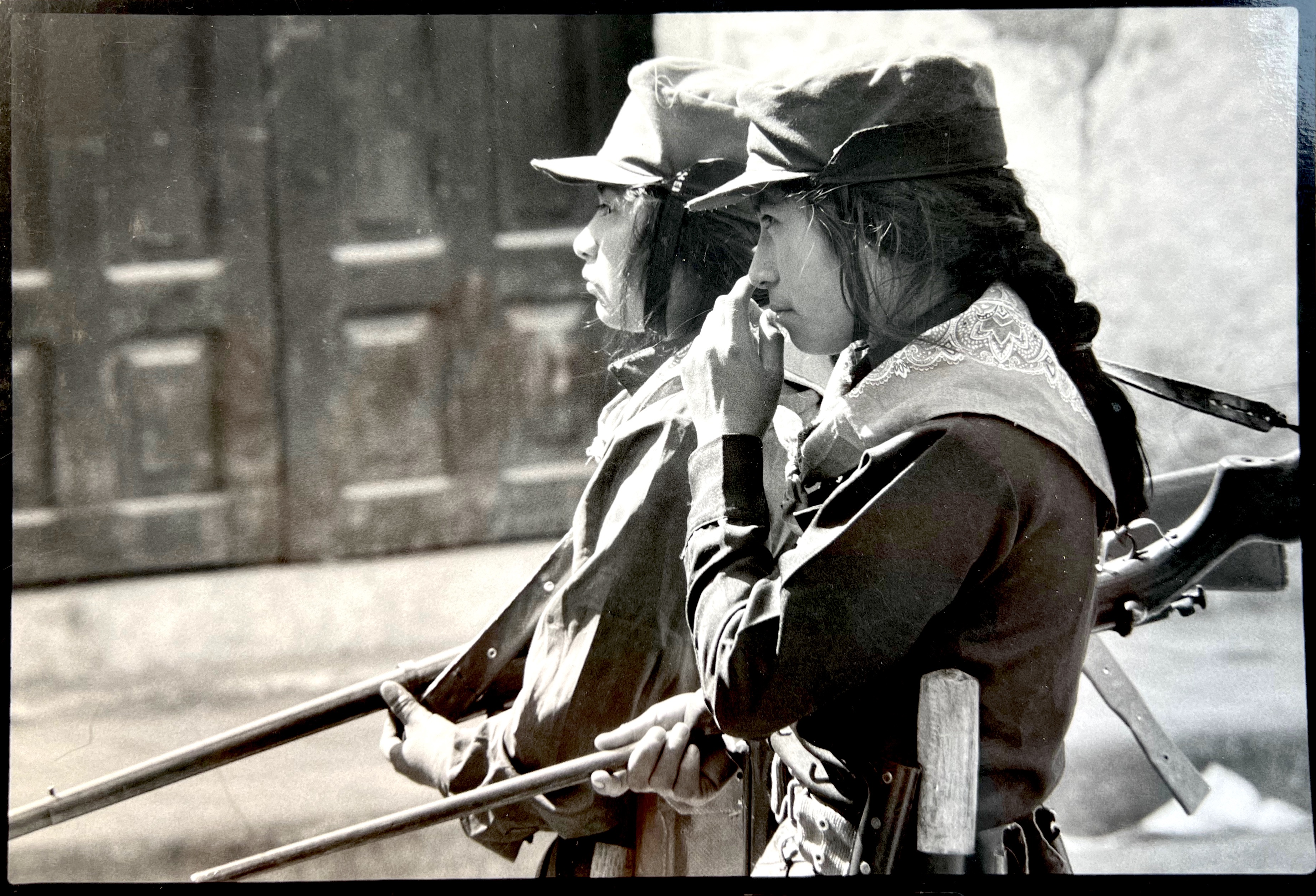
1994
11 Press Photographs of the Zapatista Uprising, Chiapas, Mexico
IMAGENLATINA. [Marco Antonio Cruz]. 11 Press Photographs of the Zapatista Uprising, Chiapas, Mexico. January 1994. Gelatin silver prints, sheets approx. 20.3 x 25.5 cm, image sizes vary slightly, most approx. 15.5 x 21 cm; all near fine except one with a 2.2 cm closed tear to white border not affecting the image. 8 with labels identifying location and photographer: Marco Antonio Cruz (5), Jose Angel Rodriguez (1), Francisco Mata Rosas (1) and Antonio Turok (1).
Vivid images of the violent initial uprising of the armed indgenous people of Chiapas against the Mexican state. On January 1, 1994 the Ejército Zapatista de Liberación Nacional [EZLN] declared war on Mexico, prompting a deadly crisis documented here by some of the era’s most important Mexican photojournalists and documentary photographers.
The conflict had its roots in both NAFTA and the revision of the Mexican constitution’s article 27 which protected indigenous lands from sale and privatization. Small paramilitary rebel groups in Chiapas merged to form EZLN and territories seized by the group in the 1990s still remain under its autonomous (but unrecognized) control.
The ImagenLatina photo agency was founded in 1986 by award-winning photographer Pedro Valtierra. A few of these images digitized in stock photo collections, most unavailable.
SOLD
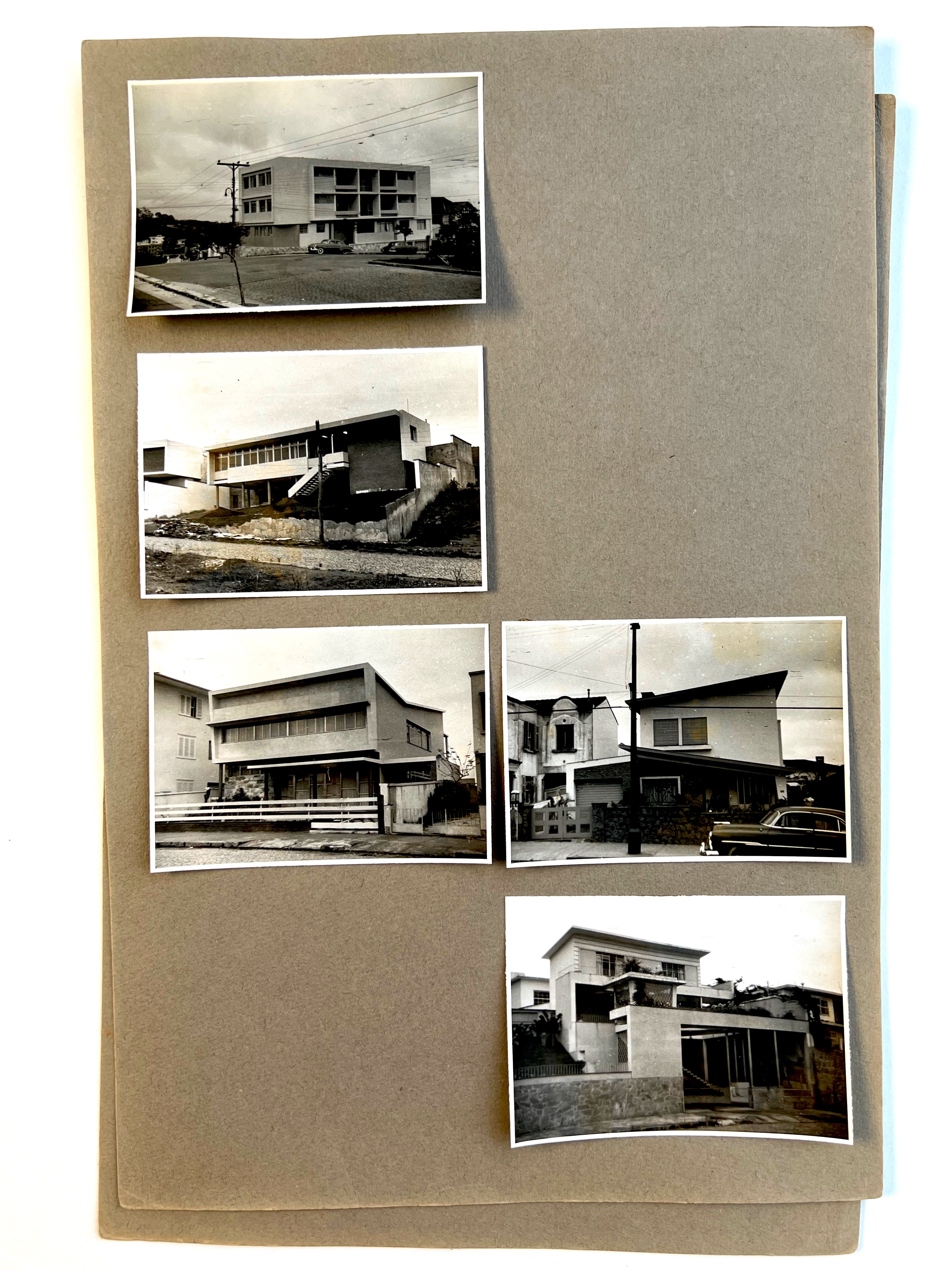
ca. 1954-1960
(Brazil) (Architecture) Vintage prints of modernist architecture in Brazil, a working/research collection?
(Brazil) (Architecture) Vintage prints of modernist architecture in Brazil, a working/research collection?
75 Photographs of Modernist Buildings
(Brazil) (Architecture) 75 Photographs of Modernist Buildings, ca. 1954-60. Gelatin silver prints, 71 approx. 9.8 x 6.5 cm, four larger, 24 x 18 cm., mounted, most on a single side or with corners, to 20 paper sheets. A few with manuscript numerical captions on the page, some with similar annotations verso. With two postcards tipped-in, one of Rio, the other of the planned campus at Pontifícia Universidade Católica. Most near fine, a few with small discolorations.
Collection of 75 images of Brazilian modern architecture, from the “first” modernist building in Rio de Janeiro, Oscar Niemeyer’s Palácio Gustavo Capanema, to the famed period of massive urban expansion under President Juscelino Kubitschek, including two Niemeyer projects in Belo Horizonte—the Auditorium of Colégio Estadual Central (1954) and the BEGME tower—as well as a number of examples under construction or recently completed, e.g. four photographs of Hospital Sul América da Instituição Larragoiti, by Niemeyer and Hélio Uchôa (1959), approx. 10 of the new Gavea campus of Pontifícia Universidade Católica (1955), and approx. five of of Jorge Machado Moreira’s Faculdade Nacional de Arquitetura Building at Federal University of Rio de Janeiro (ca. 1957), both largely unfinished projects based on Le Corbusier’s ideas about functional zoning. Includes four prints of architectural drawings, and at least three of architectural models on display, seemingly of Pontifícia Universidade Católica (PUC-RIO) and the proposed campus of Federal University of Rio De Janeiro, including grounds by Roberto Burle Marx. Another thirteen photographs of residential homes provide a fascinating look at the adaptation of these architectural vocabularies to vernacular buildings in Brazil, an architectural heritage now at risk as low-rise neighborhoods give way to high-rise development.
The photographs were taken over the course of 5 or 6 years of deliberate inquiry by an unknown researcher or professional. The sometimes informal compositions reveal glimpses of the unbuilt environments in which many of the projects arose: savannas, forests, and manmade islands; the architectural designs of PUC-RIO by Edgar de Oliveira da Fonseca (architect of Rio’s Metropolitan Cathedral) raise questions about a plan that is largely absent from conversations about Brazilian modernism in the 1950s, despite the fact that they strongly echo Niemeyer and Affonso Riedy designs.
A few photographs as yet unidentified.
SOLD
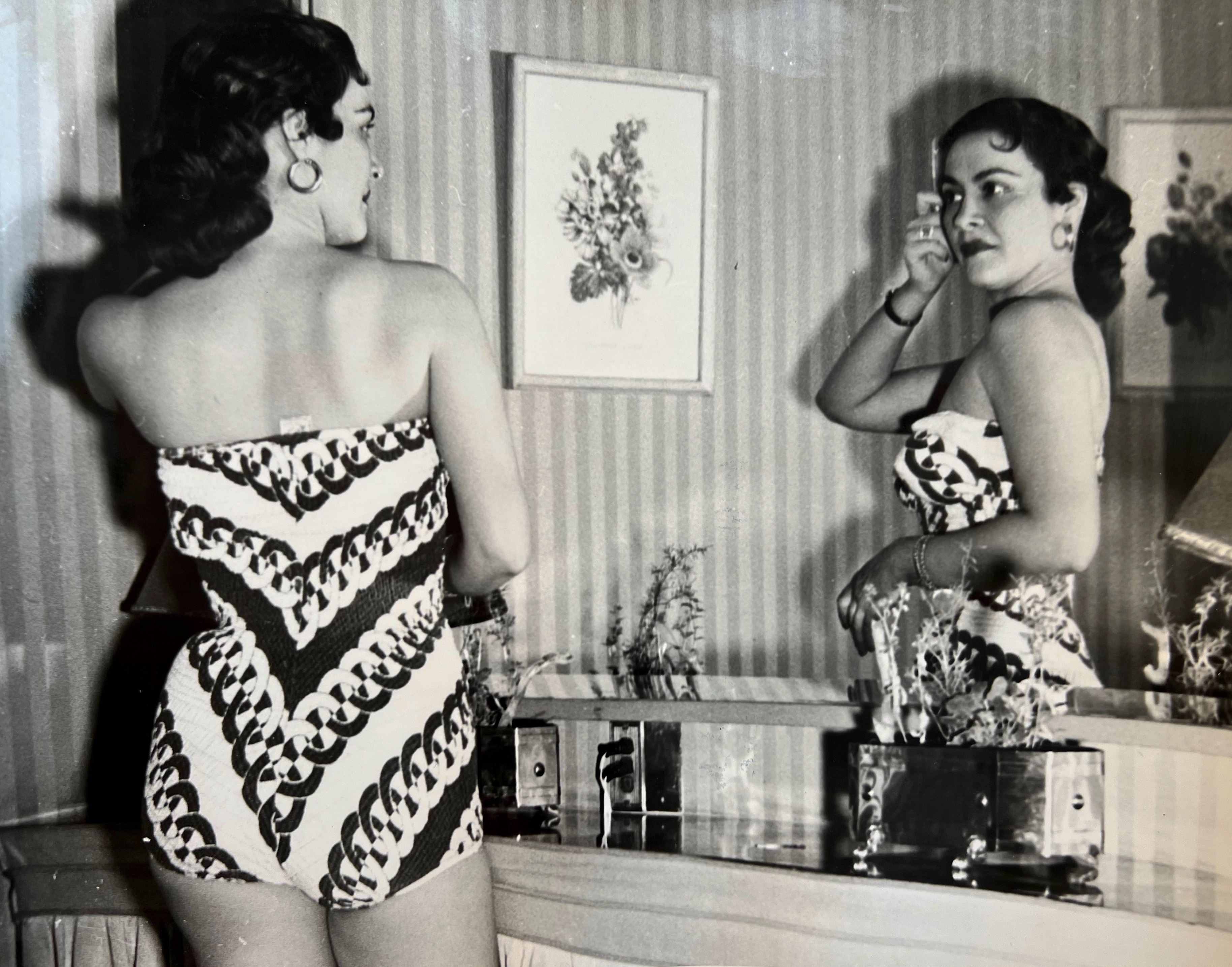
Antonio R. Caballero ca. 1965
Vintage prints from a pioneer of the "fotonovela" genre.
Vintage prints from a pioneer of the "fotonovela" genre.
Nine Photographs
Caballero, Antonio R. Nine Photographs, ca. 1965. Gelatin silver prints, six approx. 25.5 x 20.5 cm each; three approx. 17.5 x 12.6 cm each. All with studio stamp verso, some with editing marks verso or typed captions.
Antonio Caballero is recognized as a pioneer of the Mexican “fotonovela” genre; a narrative multi-image format published in various tabloids in the 1960s and 1970s that mirrored the style and melodramatic themes of telenovelas. In both a 2019 retrospective of his work at the Museo de Arte Moderno, Mexico City, and a 2011 exhibition in New York, his photographs in the style of the present group were praised for a campy, vernacular style that riffed on Pop motifs and quintessential aspects of 60s aspirational Mexican bourgeois culture.
Caballero is also known for an infamous, explicit photograph of Marilyn Monroe, taken at the Mexico City Hilton in 1962, a few months before her death.
$1050
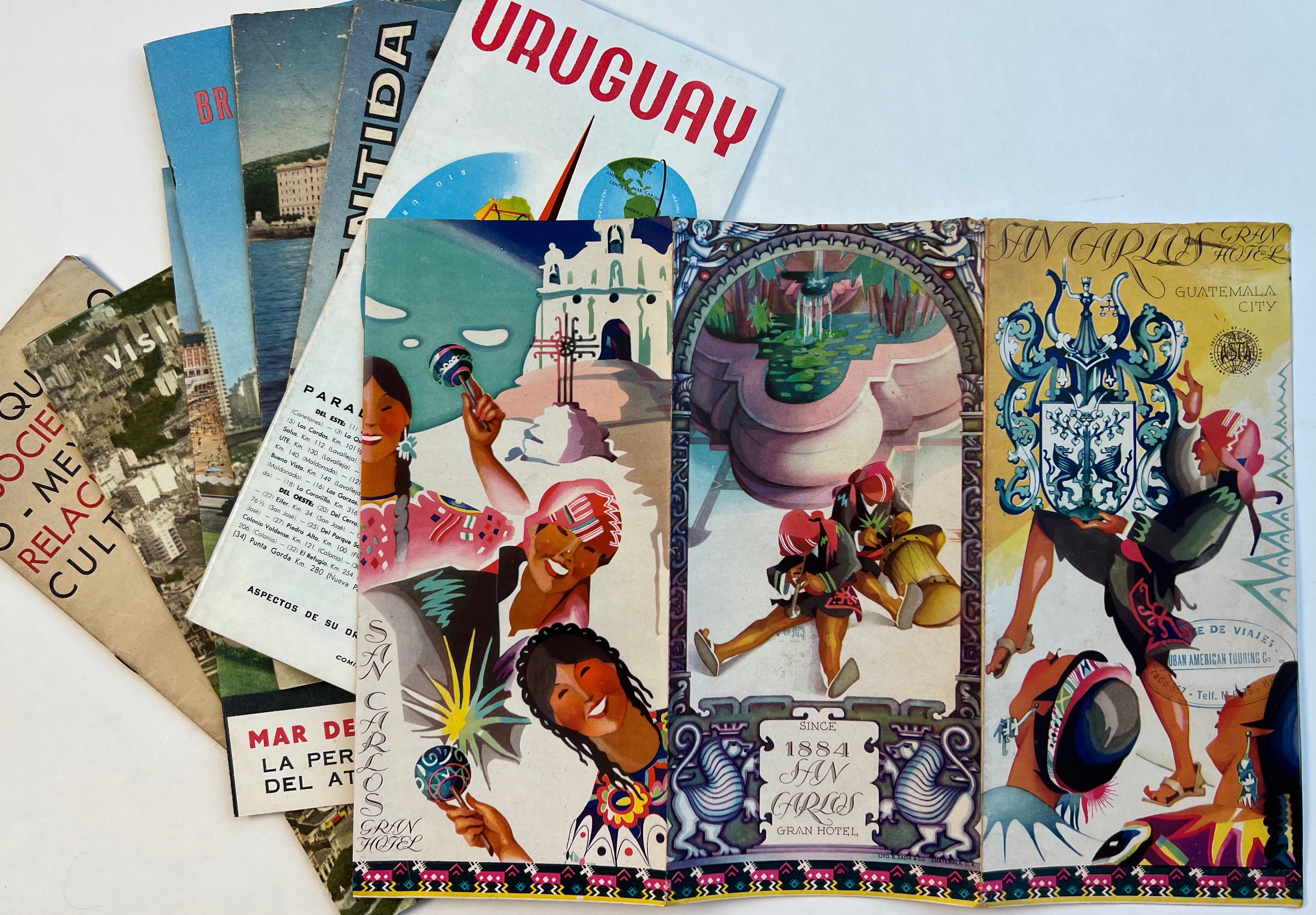
ca. 1950-1970.
Eight Central and South American Tourist Pamphlets
Eight Central and South American Tourist Pamphlets, ca. 1950-1970. Most approx. 23 cm (folded), multi-fold single sheets with varying sizes, up to [24] pp., one stapled [20] pp. + folding map; Spanish except San Carlos Gran Hotel, Guatemala City, in Eng.; color illus., many with maps and or graphs, varying conditions, two with manuscript annotations inside and/or recto, overall about Good-.
Postwar graphic treatment promoting modern tourist experiences in Argentina (2), Brazil (1), Guatemala (1), Mexico (1), and Uruguay (3). Mexico pamphlet promoting a week-long festival of the Sociedad Cubano-Mexicana de Relaciones Culturales (1963). Uruguay pamphlet advertising social and public benefits systems as well as tourism.
$100
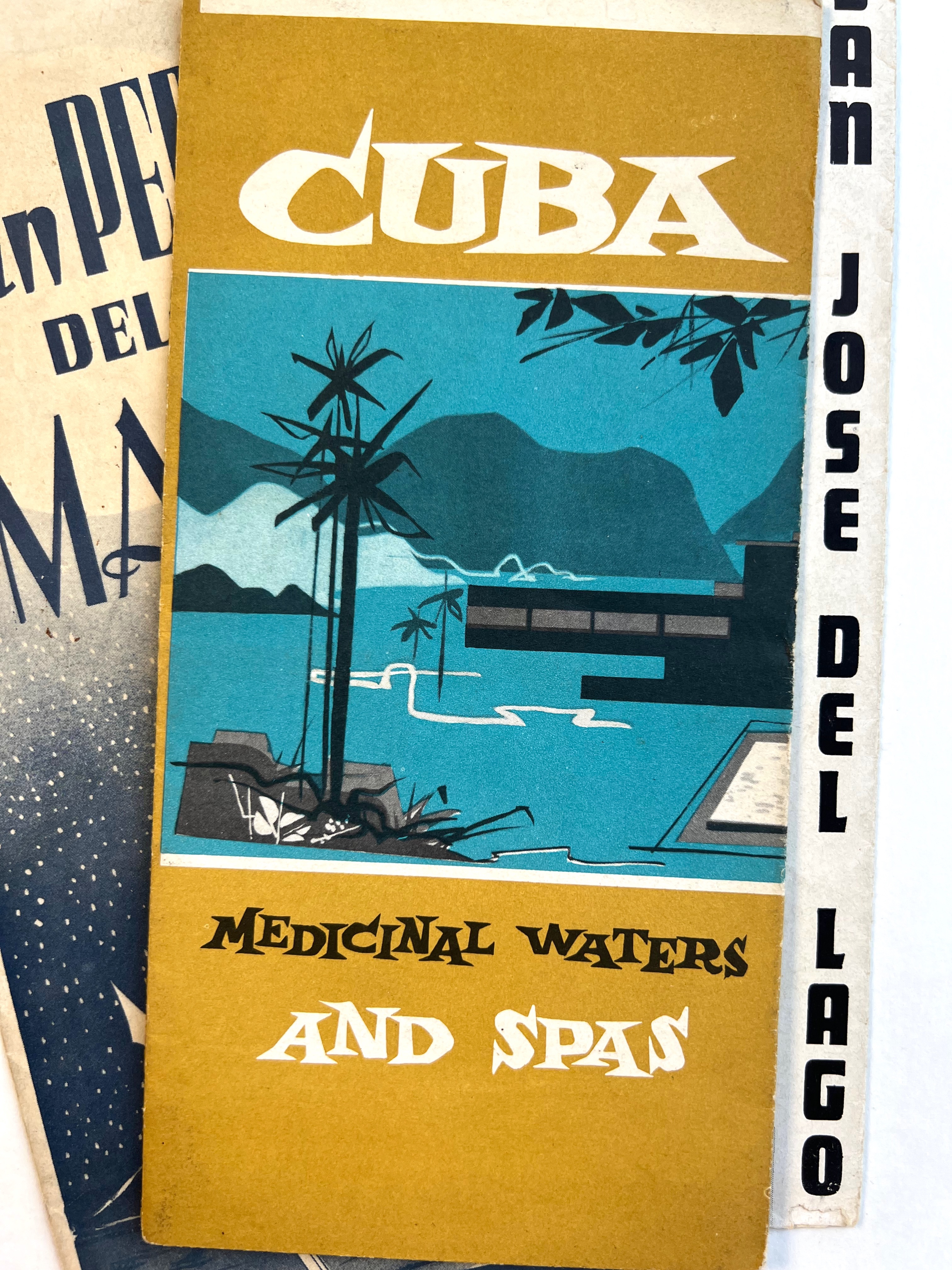
ca. 1950-1983
16 Cuban Tourist Pamphlets and Handbills
(Cuba) (Tourism) 16 Cuban Tourist Pamphlets and Handbills, ca. 1950-1983. Most approx. 23 cm (folded) multi-fold single sheets with up to [12] pp.; color illus., many with maps, varying conditions, two with manuscript annotations recto, overall about Good.
With an equal number of pre- and post-1959 examples, this small collection tracks the shifts in tourism that occurred in Cuba after the Revolution. Changes in marketing and activities focused on a largely European, rather than American, visitor, introducing a new emphasis on camping and nature (rather than hunting and clubbing). Examples from 1960-1983 published by the Instituto Nacional de la Industria Turística.
Includes a number of pamphlets for the Isla de Pinos/Isla de la Juventud, including two pre-1960 examples featuring the modernist new annex of the Hotel Santa Fe, now gone?
$400
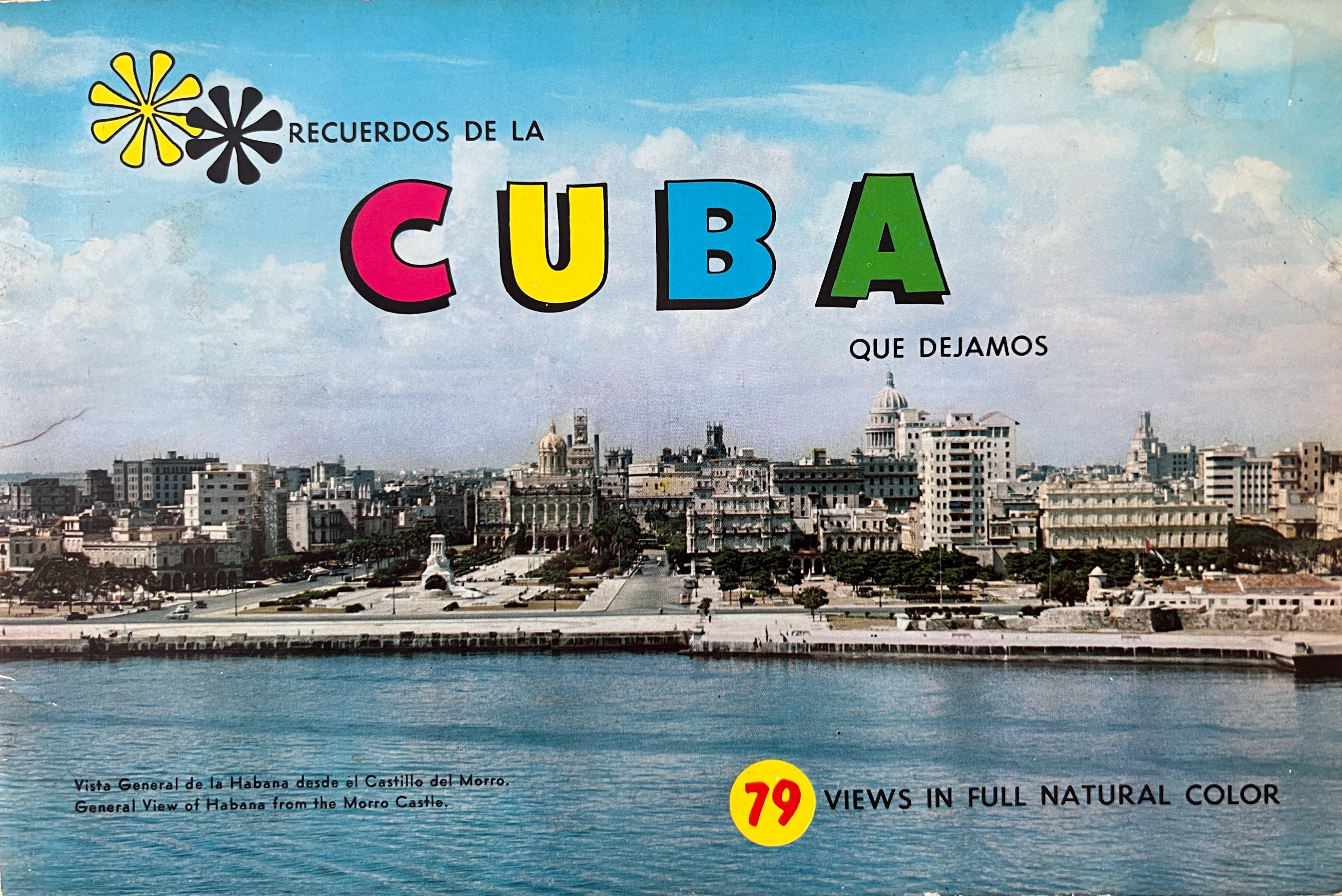
1963?
Nostalgic, anticommunist Cuban photo booklet.
Nostalgic, anticommunist Cuban photo booklet.
Recuerdos de la Cuba que Dejamos
(Cuba) (Exile) Recuerdos de la Cuba que Dejamos [cover title]. Forest Hills, N.Y. : AZEFA Trading. Co., n.d. [1963? 1966?]. Oblong 23 cm, [24] pp.; bilingual color photobook, reproducing 79 images “in full natural color.” Stapled color wrappers, a bit worn, rubbed at spine.
Book memorializing midcentury Cuba before the Revolution. Spanish and English introductions are not the same, but both invoke a beloved “free” Cuba, the patriotism of Cubans living in exile in the US, and propose a “second liberation” that is close at hand.
Images focus on architectural and urban features with an emphasis on modern development before 1959. Possibly issued twice, or simultaneously, in Miami and New York.
Six OCLC holdings.
$125
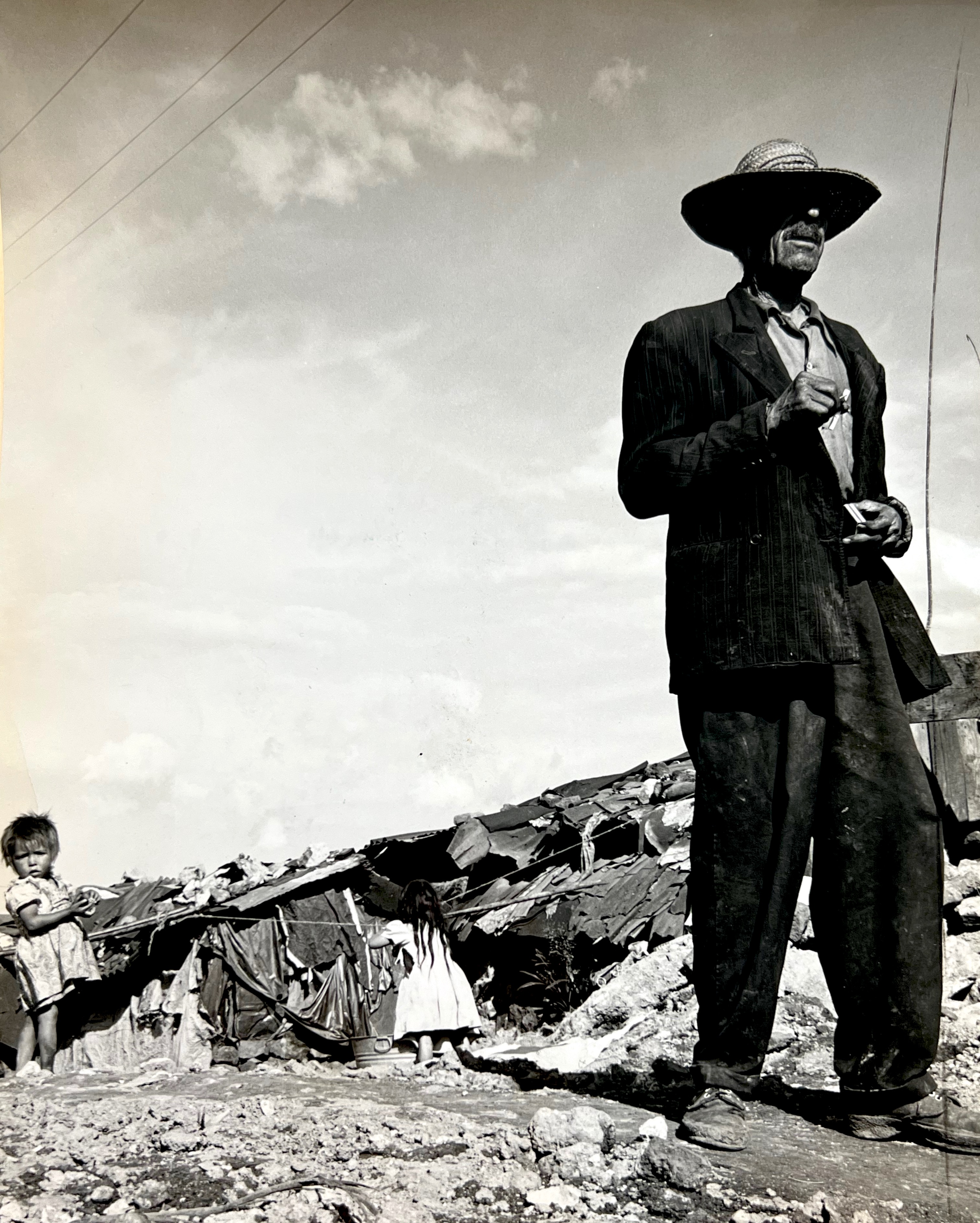
Hector García ca. 1955-1960
Untitled Photograph
García, Hector. Photograph, ca. 1955-1960. Gelatin silver print, 24 x 19.5 cm. Studio stamp verso. Editor’s pencil crop marks recto. VG+.
Evocative print by the acclaimed Mexican photojournalist. Despite the historical significance of his work documenting the Pachuco culture and Mexico City’s slums in the 1950s, holdings of vintage García prints are scarce in US institutions and often limited to portraits of his famous friends (Kahlo, Rivera, etc.).
SOLD
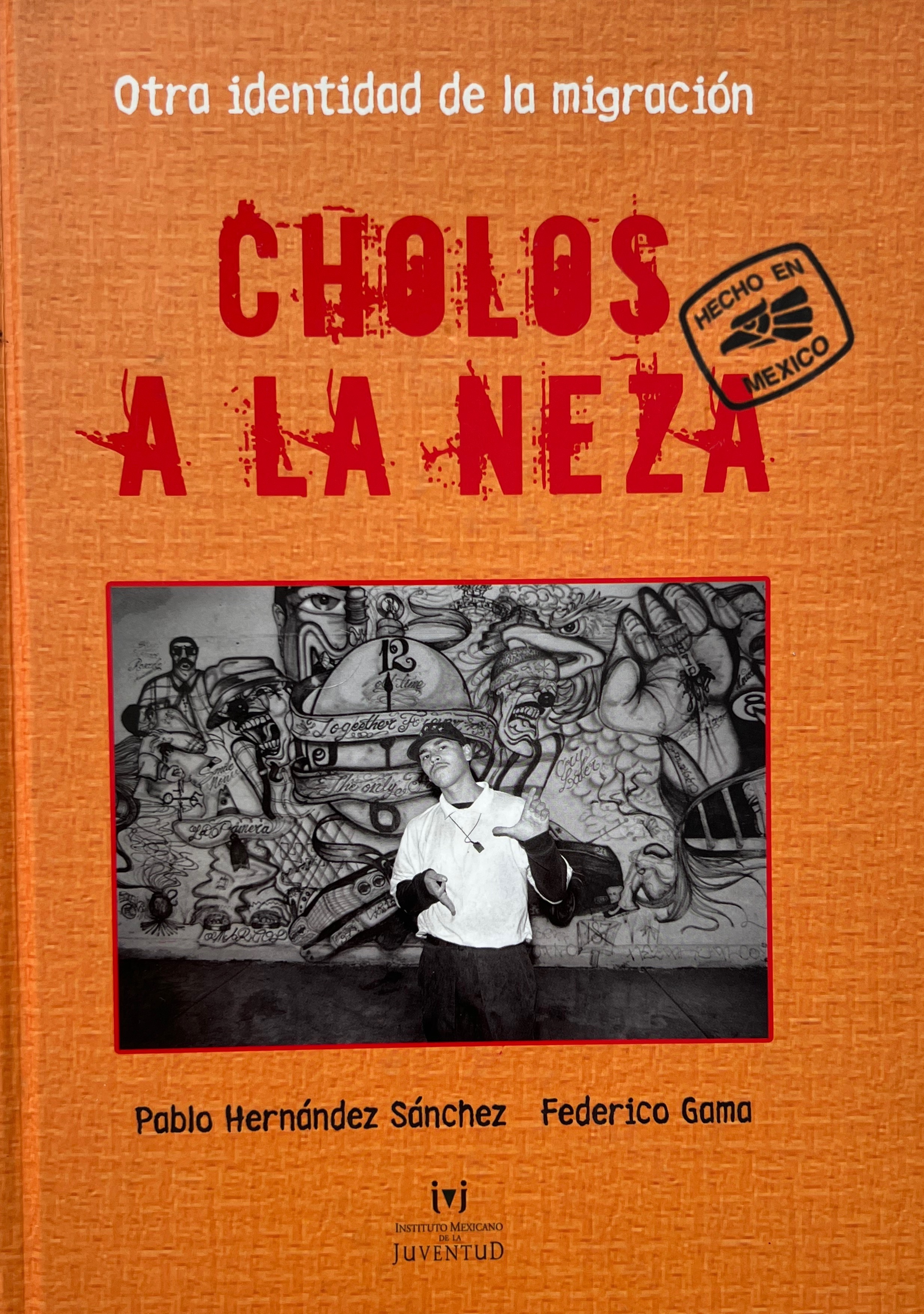
Pablo Hernandez Sanchez and Federico Gama 2007
(Migration Studies) Photobook exploring the effects of cyclical migration on cholo culture in Ciudad Nezahualcóyotl, D.F.
(Migration Studies) Photobook exploring the effects of cyclical migration on cholo culture in Ciudad Nezahualcóyotl, D.F.
Cholos a la Neza: Otra identidad de la migración
(Photography) (Migration Studies) Hernandez Sanchez, Pablo and Federico Gama. Cholos a la Neza: Otra identidad de la migración. México, DF: Instituto Mexicano de la Juventud, 2007. 26 cm, 134 pp.; profusely illustrated, color boards, sl. dinged at edges.
Documents the cholo identity (tattoos, fashion, cars, music, funerals) of youth in Ciudad Nezahualcóyotl (aka “Neza”) from the late 1990s-early 2000s. Neza contains part of one of the largest slums in the world and endemic gang violence. Examines the relationship between this culture and cyclical migration between the US and Mexico; focusing on the adaptation of US cholo culture to communities of origin, and the symbolic recovery of pre-Hispanic elements in the styles of the Neza cholos.
Uncommon, five US holdings in OCLC.
ON HOLD
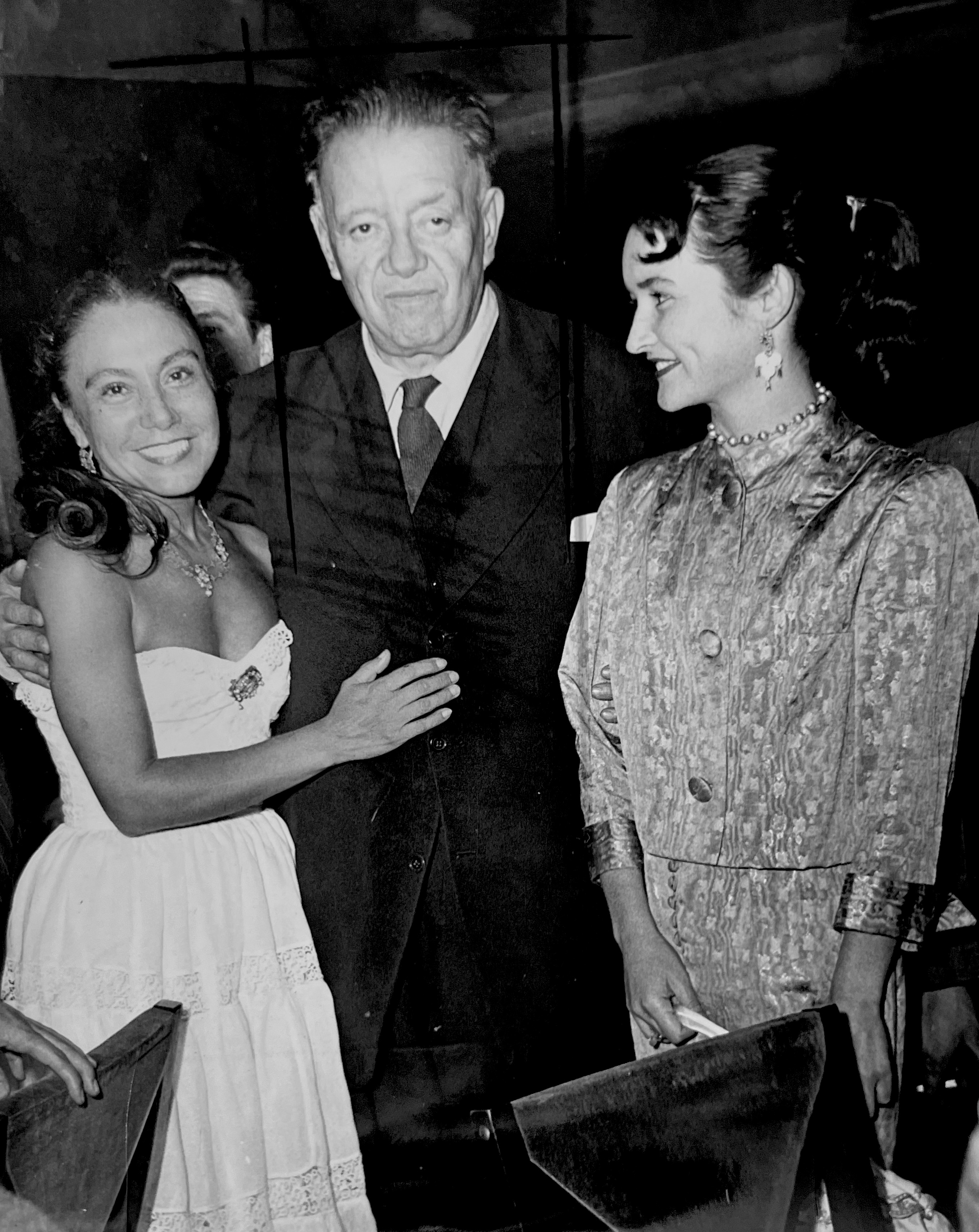
[Rina Wasern Lazo and Diego Rivera] ca. 1950
Scarce documentation of the Guatemalan muralist Rina Lazo and her mentor, Diego Rivera.
Scarce documentation of the Guatemalan muralist Rina Lazo and her mentor, Diego Rivera.
Two Photographs
[Lazo, Rina Wasern and Diego Rivera]. Two Photographs, ca. 1950. 13 x 17.5 cm. One captioned verso, the other with marks by the photographer or editor. Crop marks recto.
Photographs depict the Guatemala muralist Rina Lazo with her mentor, Diego Rivera. The two painters worked together on a number of commissions, she is best known for her murals at the Museo Nacional de Antropología in Mexico City.
$250
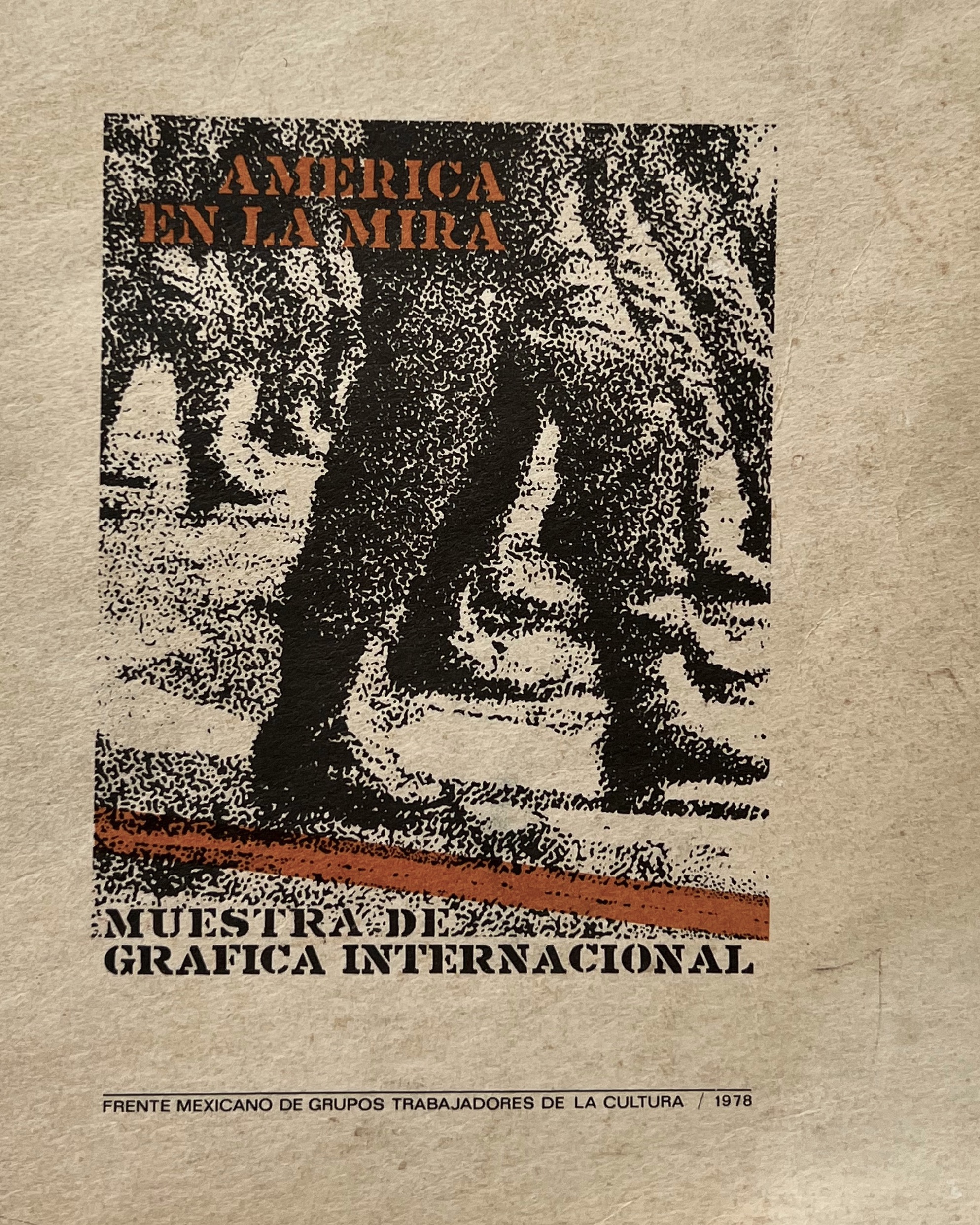
Frente Mexicano de Trabajadores de la Cultura 1978
Marxist "Grupos" art movements of the 1970s.
Marxist "Grupos" art movements of the 1970s.
America en la Mira: Muestra de Grafica Internacional
[Frente Mexicano de Trabajadores de la Cultura] and [Alberto Hijar]. America en la Mira: Muestra de Grafica Internacional. Exh. Cat. Mexico D.F.: Frente Mexicano de Trabajadores de la Cultura, 1978. 28 cm, 192 pp.; intro and back matter tog. with 162 b/w pls. of works in the exhibition, small dampstain in lower corner of first quarter of text block, not affecting images. Illus. wrappers, heavily worn with closed tears on rear wrapper and two deep dents.
Catalogue documenting the early days of the emerging Marxist “grupos” movement – a response to the controversial X Paris Youth Biennial (1977) where Mexico was excluded from the larger Latin American pavilion because of the political content of its artwork. El Frente Mexicano de Trabajadores de la Cultura was made up of a number of the groups, or members of the groups, selected by Helen Escobedo for the Paris exhibition including members of Grupo Mira, Grupo Suma, Grupo Taller de Arte e Ideología (TAI), Proceso Pentágono, etc. These groups protested the Mexican regime, supported global anti-capitalist and anti-colonial struggles, and identified themselves as “cultural workers” rather than artists. This first exhibition of El Frente brought together an international network of such workers creating “combative graphics.”
Polemical intro texts by Alberto Hijar (UNAM) and others demonstrate ongoing tensions between radical student groups and solidarity with the Sandanista movement and other workers movements in el Cono Sur. The exhibition was displayed in university and museum galleries across Mexico and included work from the San Francisco Poster Brigade and La Raza Silkscreen Center (San Francisco), Los dos Streetscapers (Los Angeles), Untel (Paris), Cuatro (Morrocco), and El Centro Experimental (Naples).
Four copies recorded in North American OCLC member holdings.
SOLD
